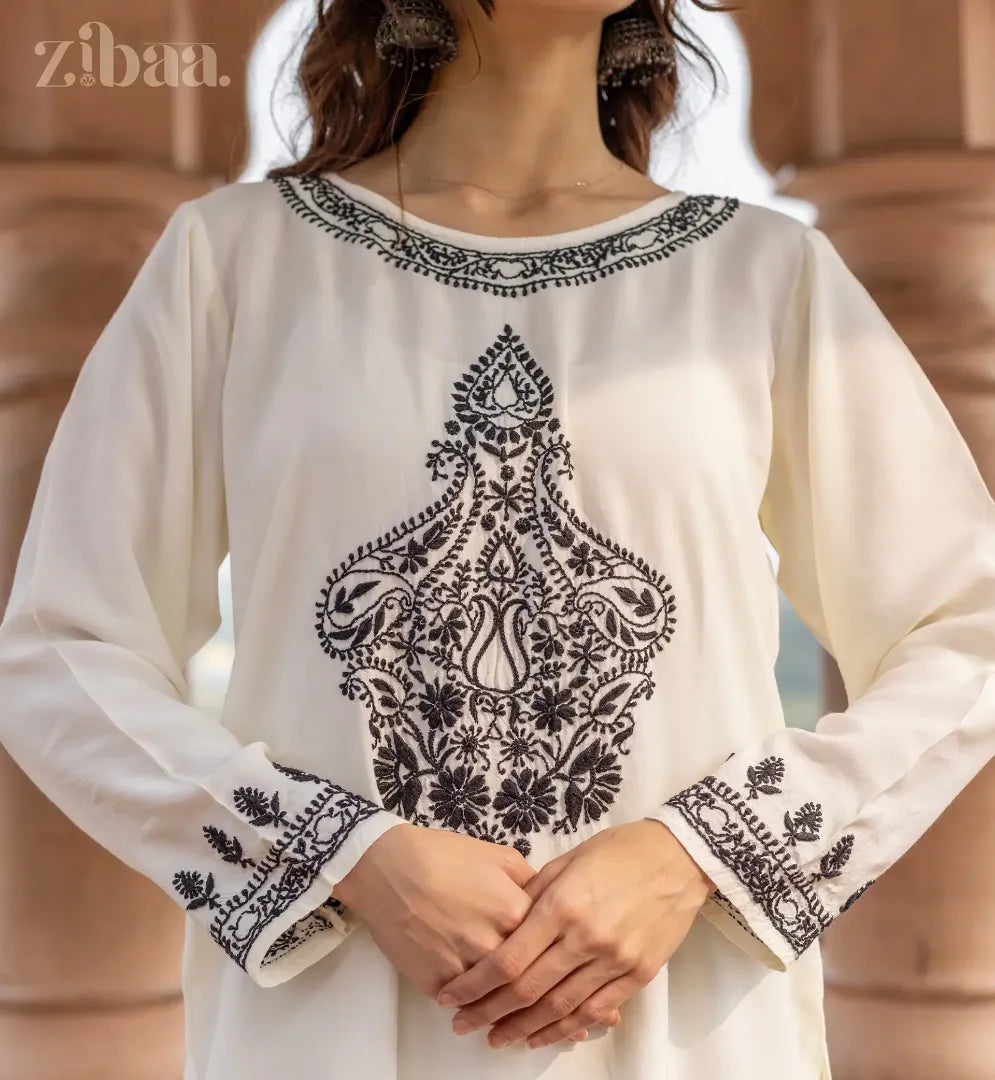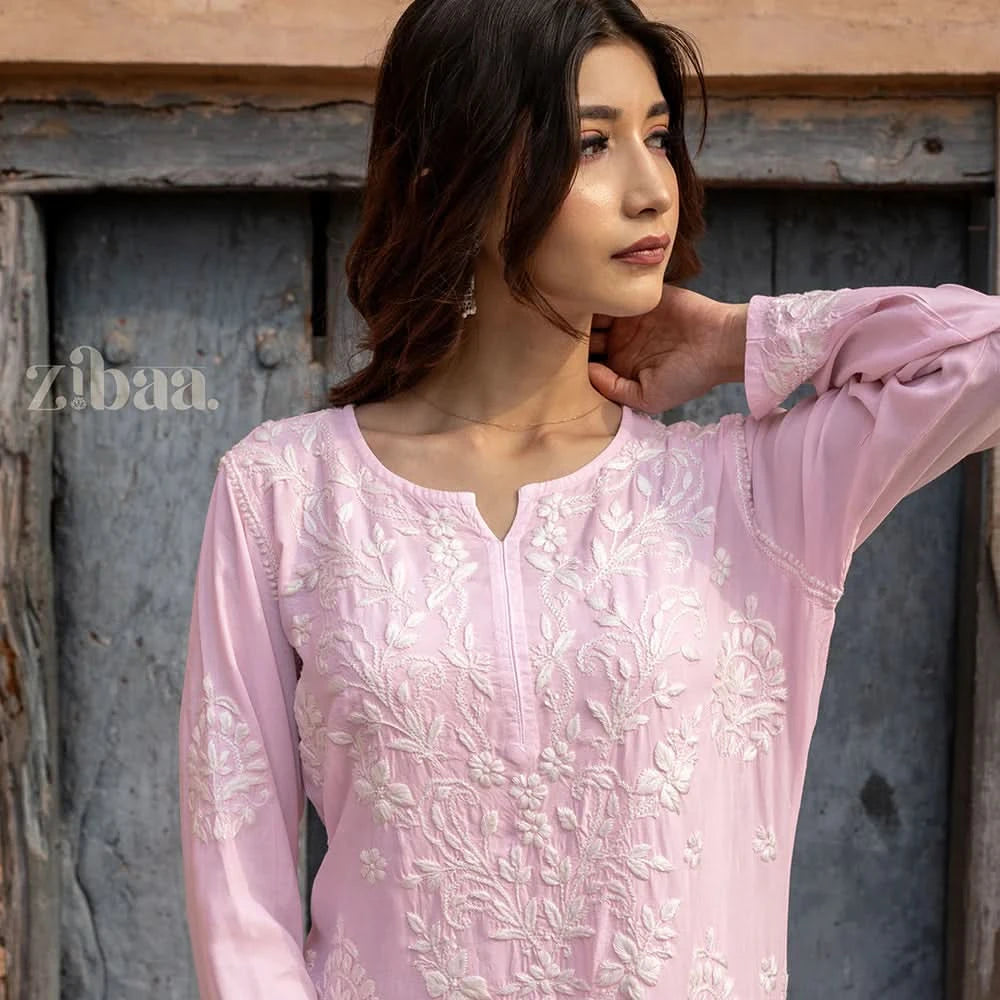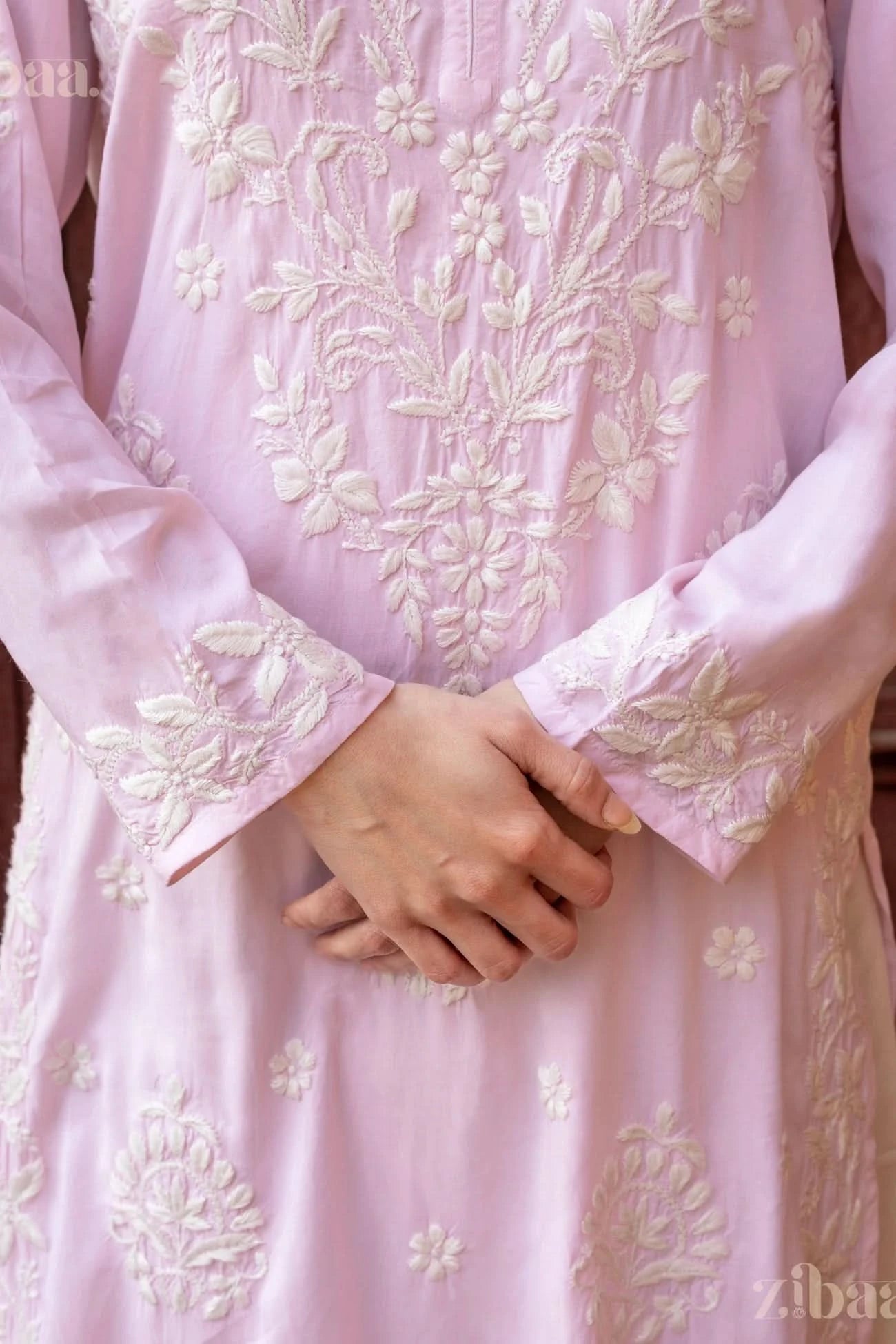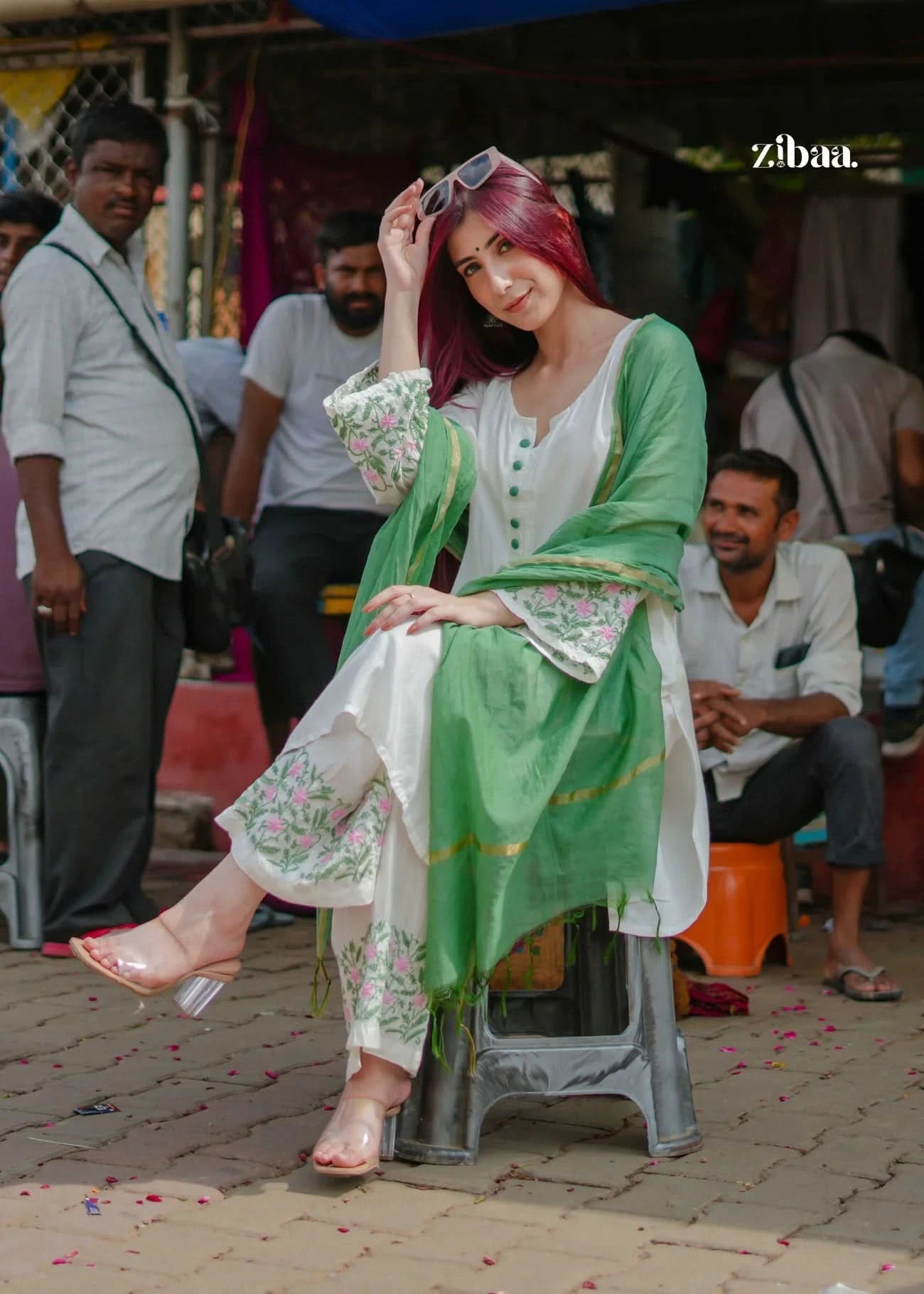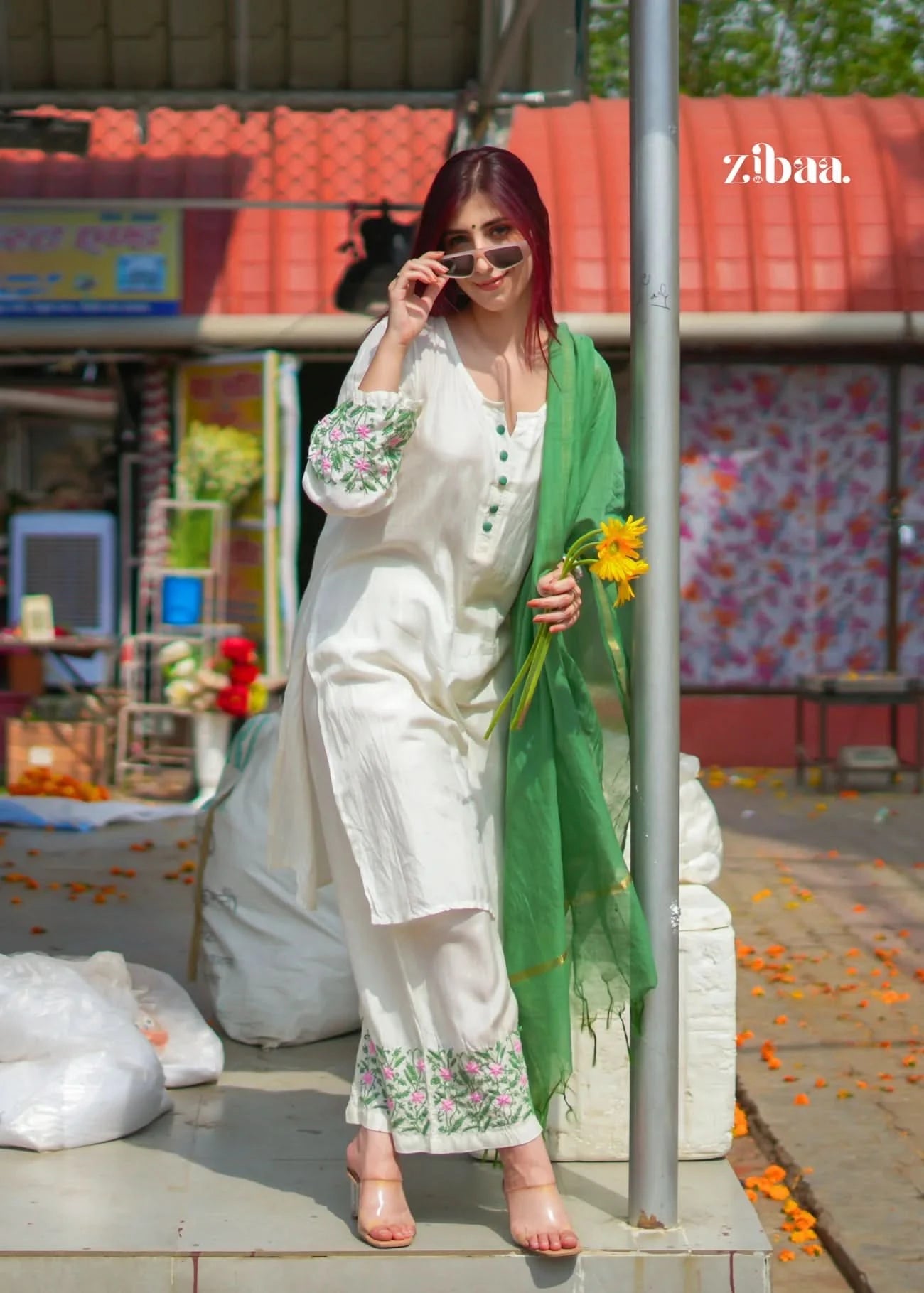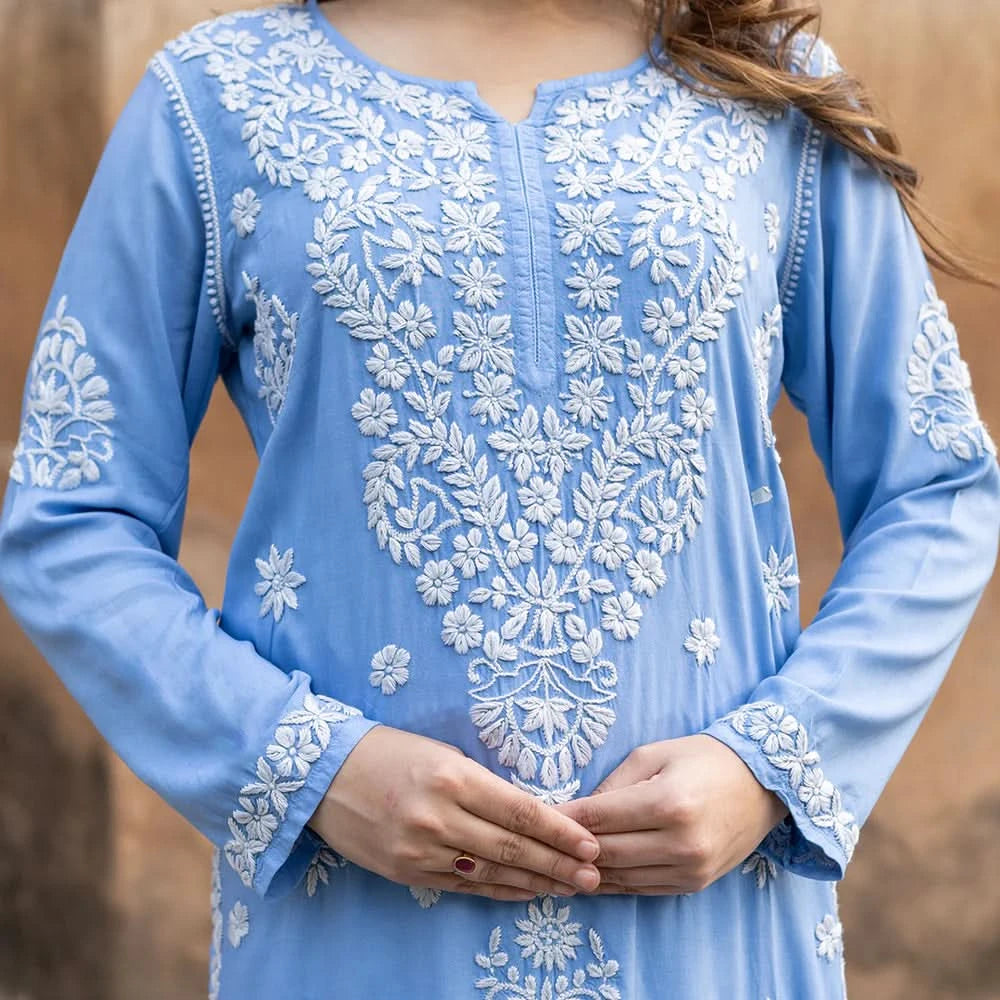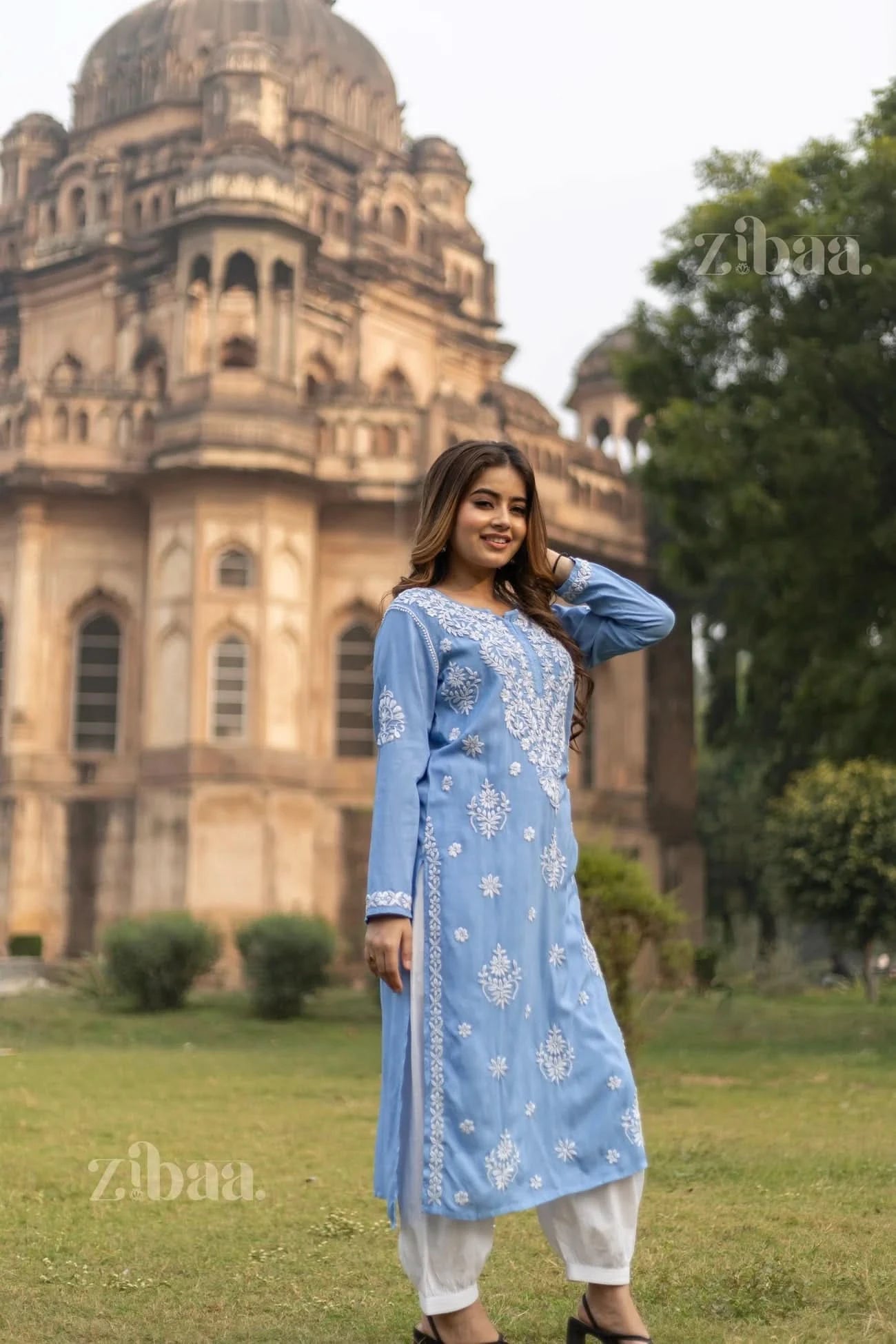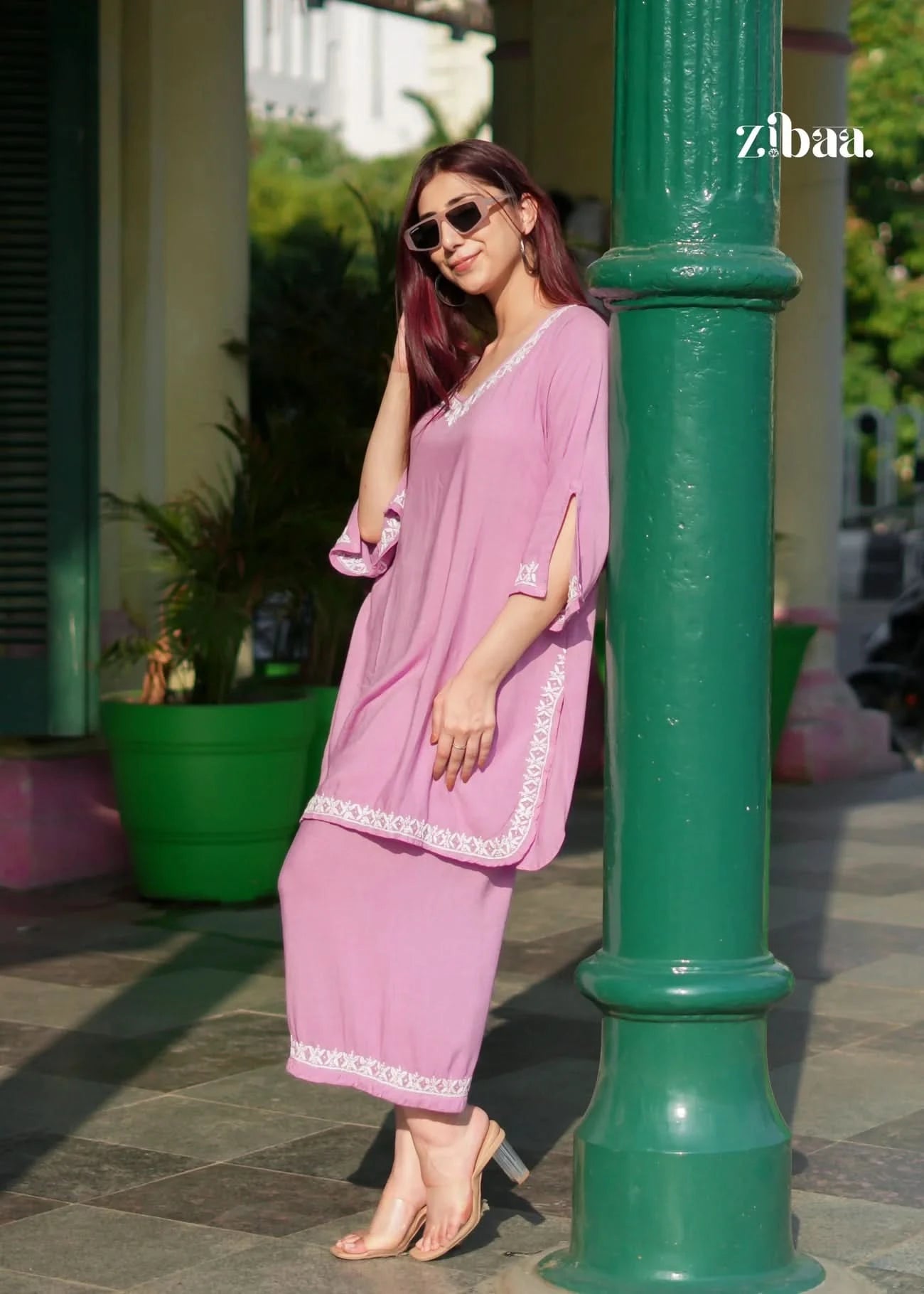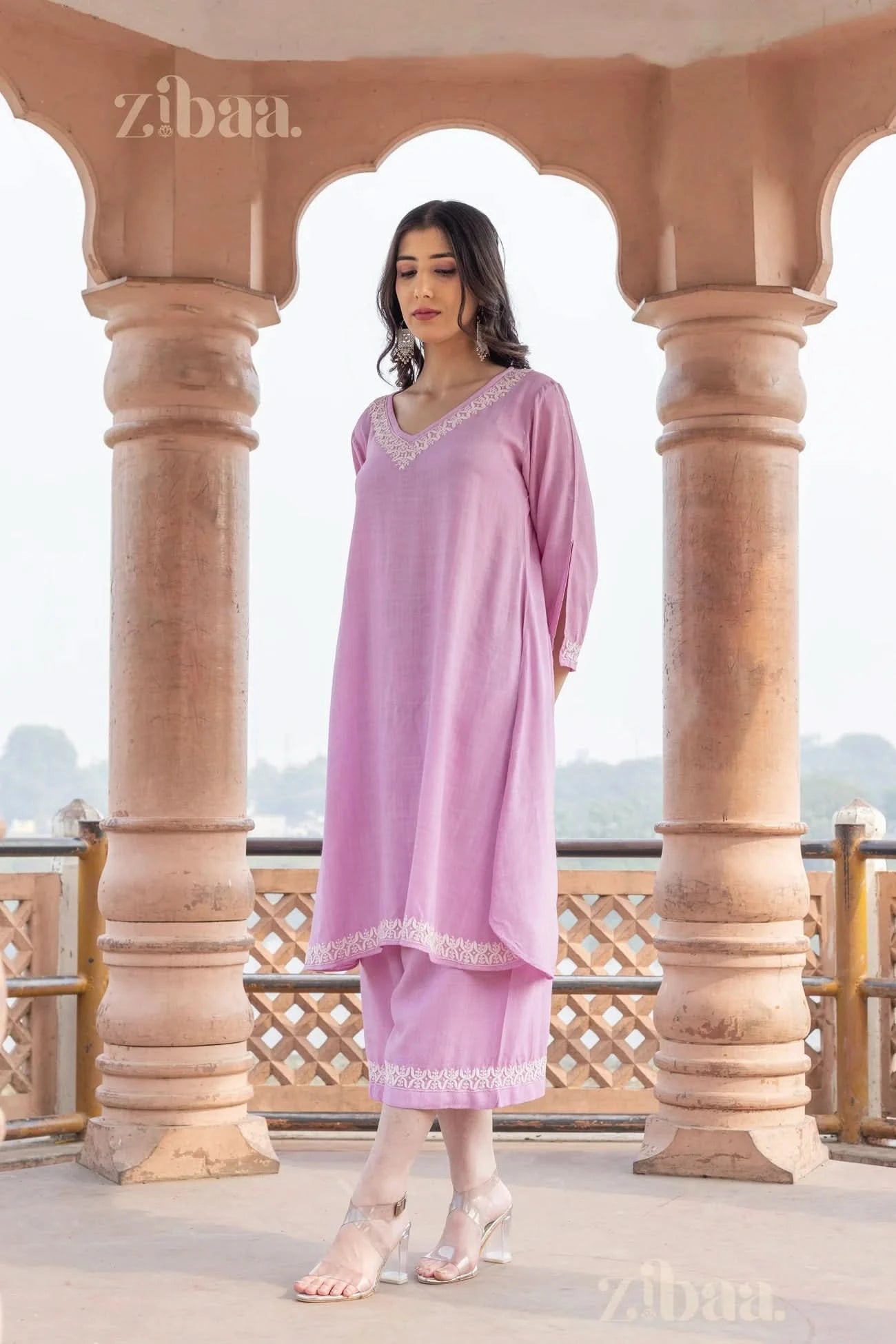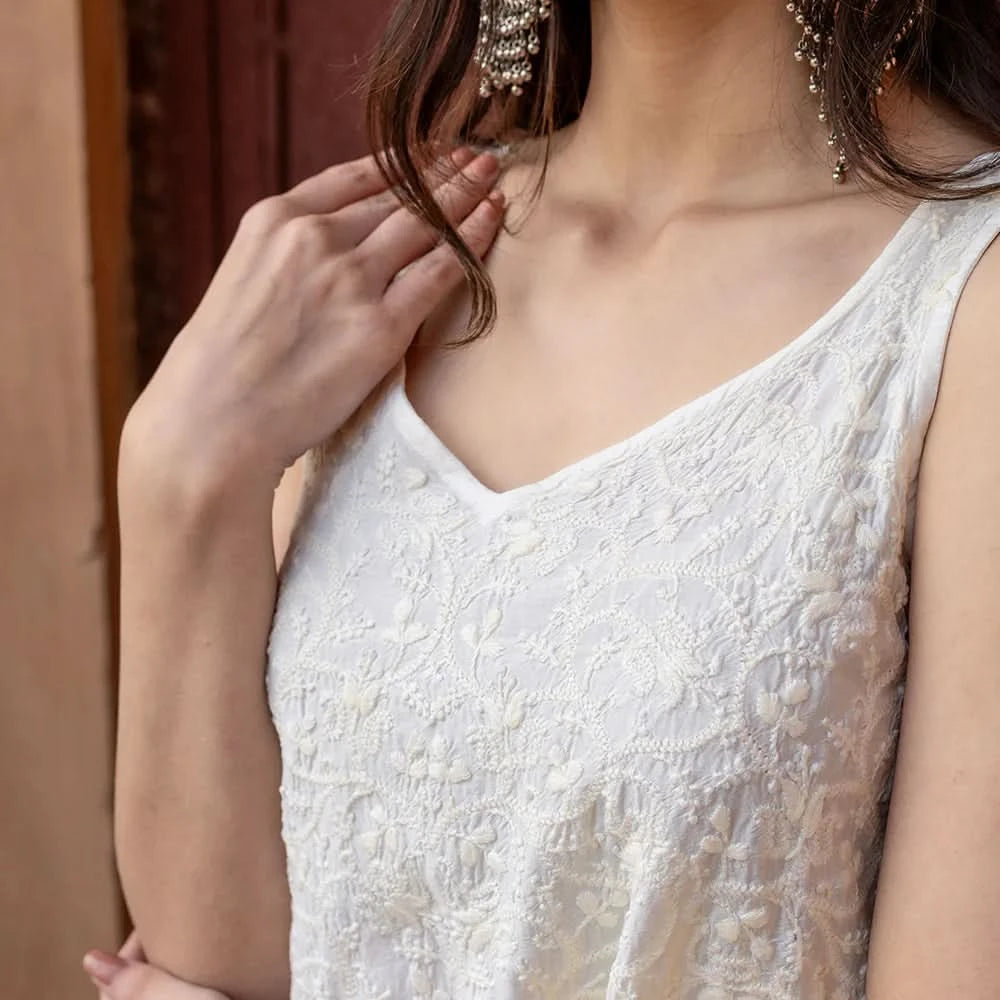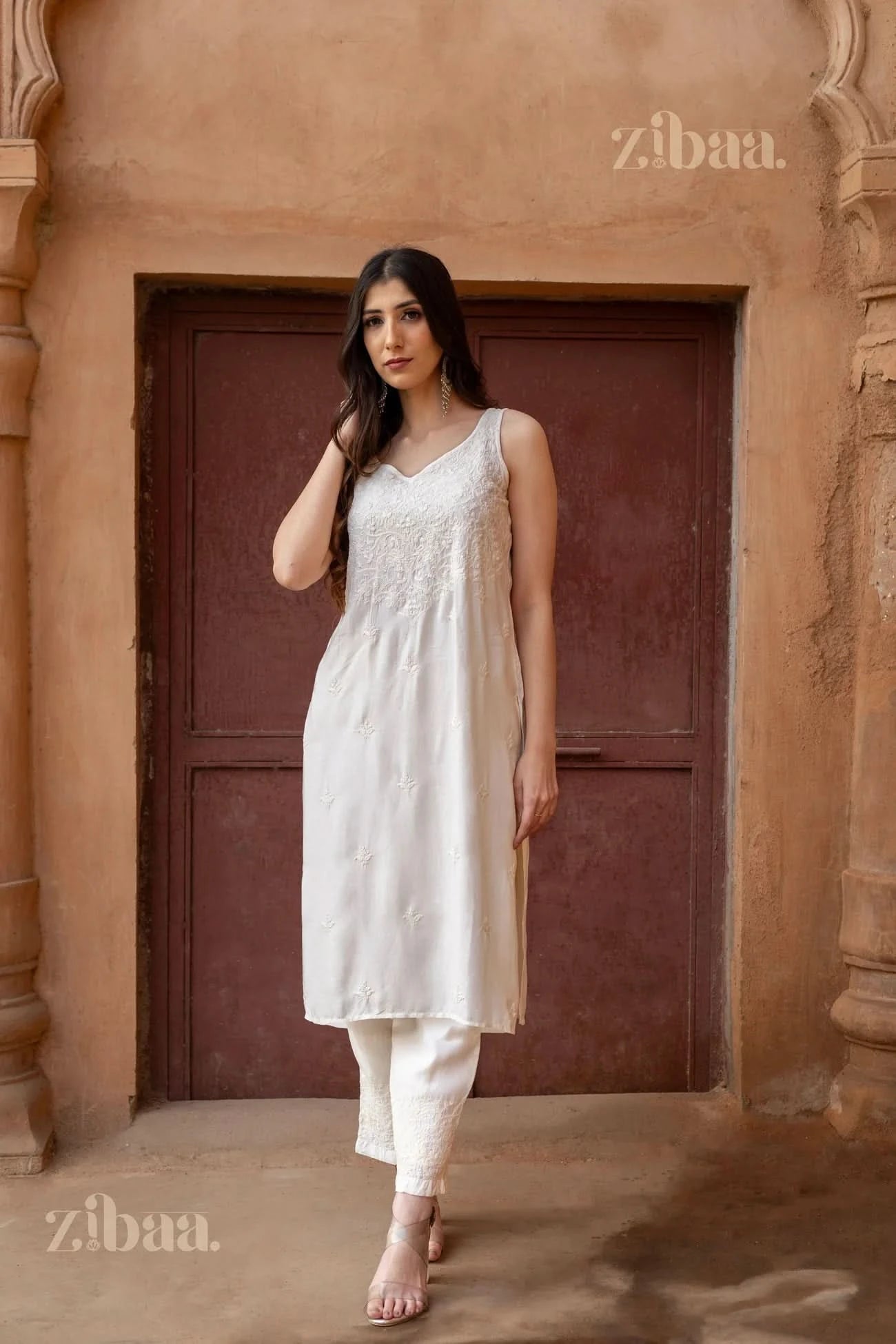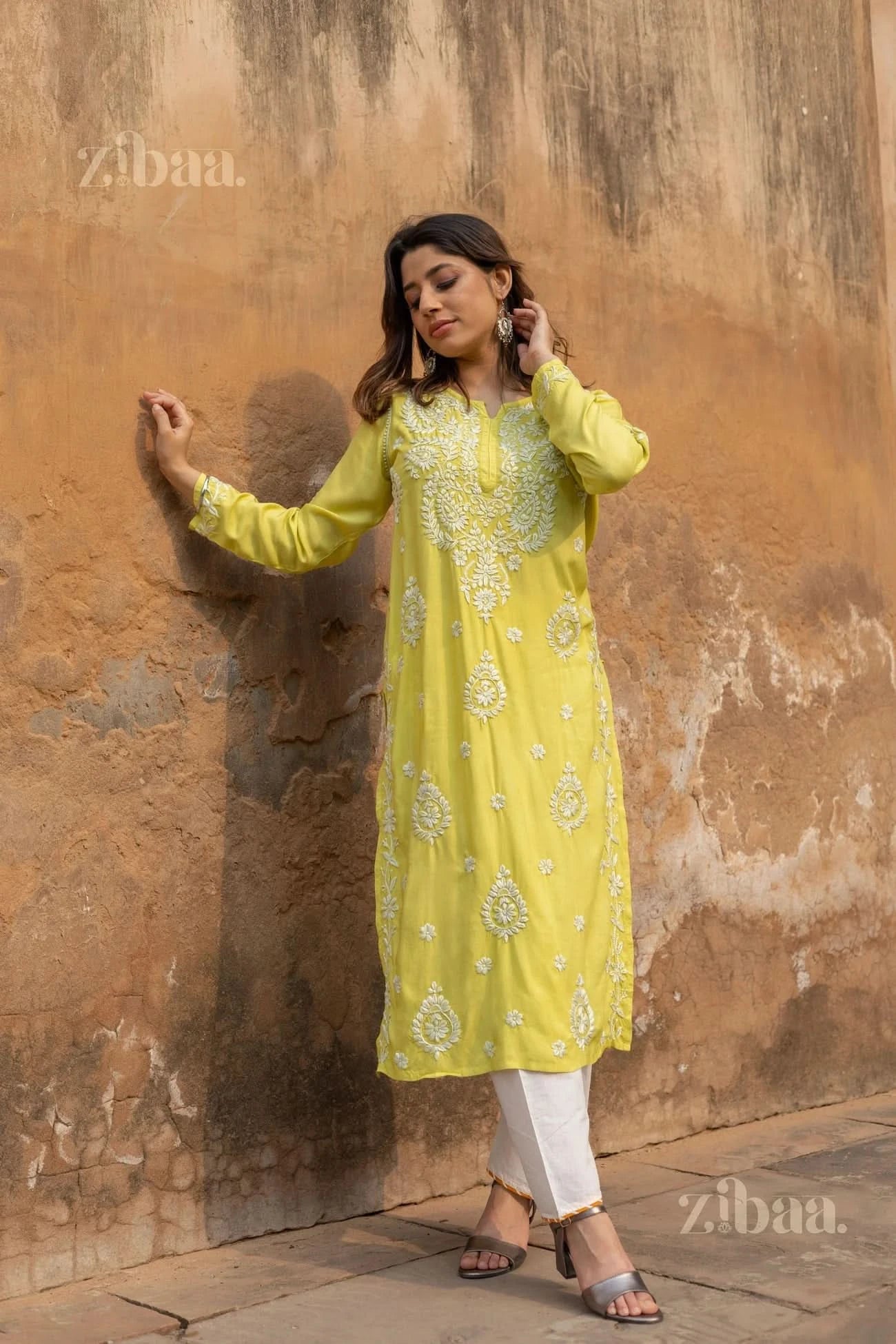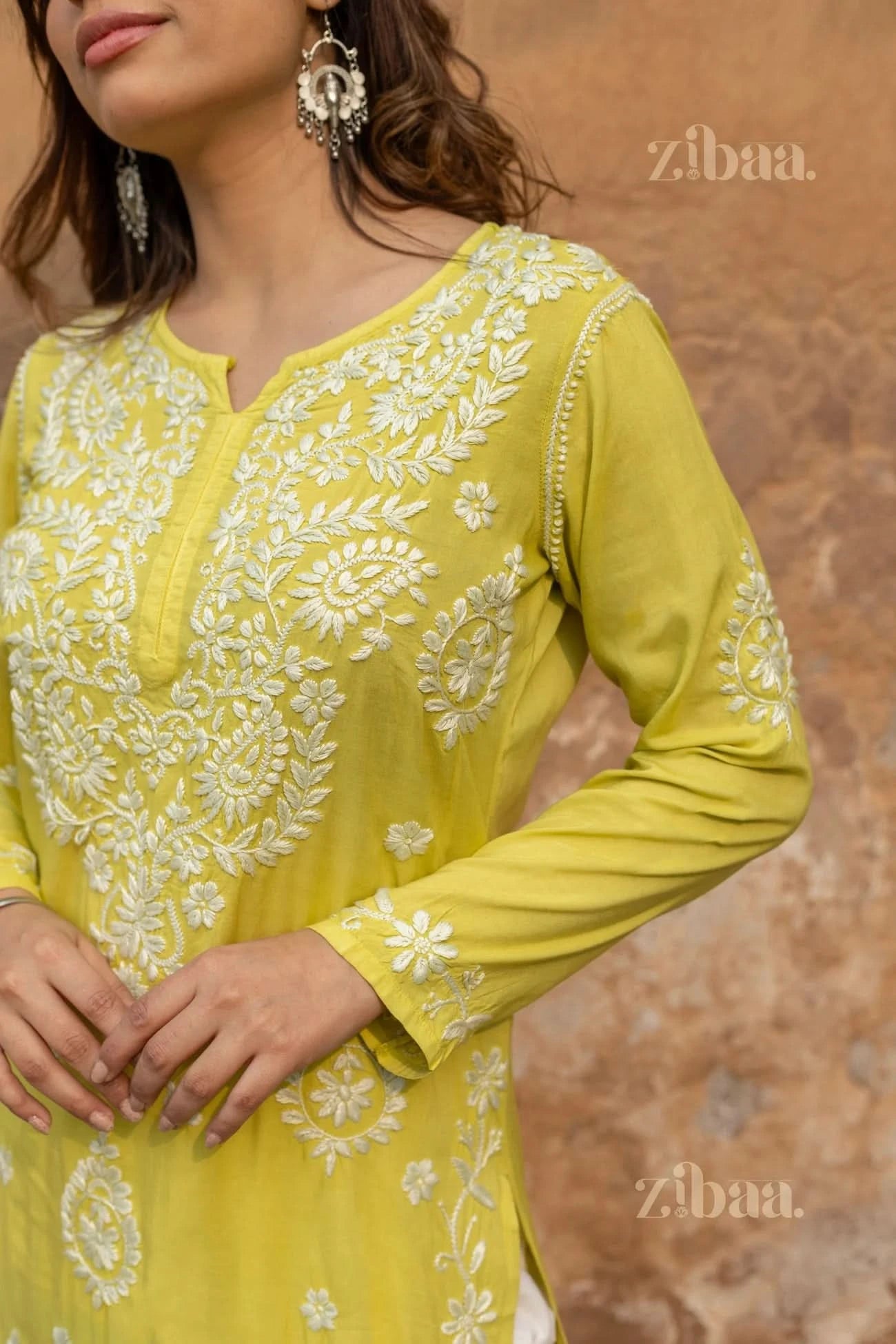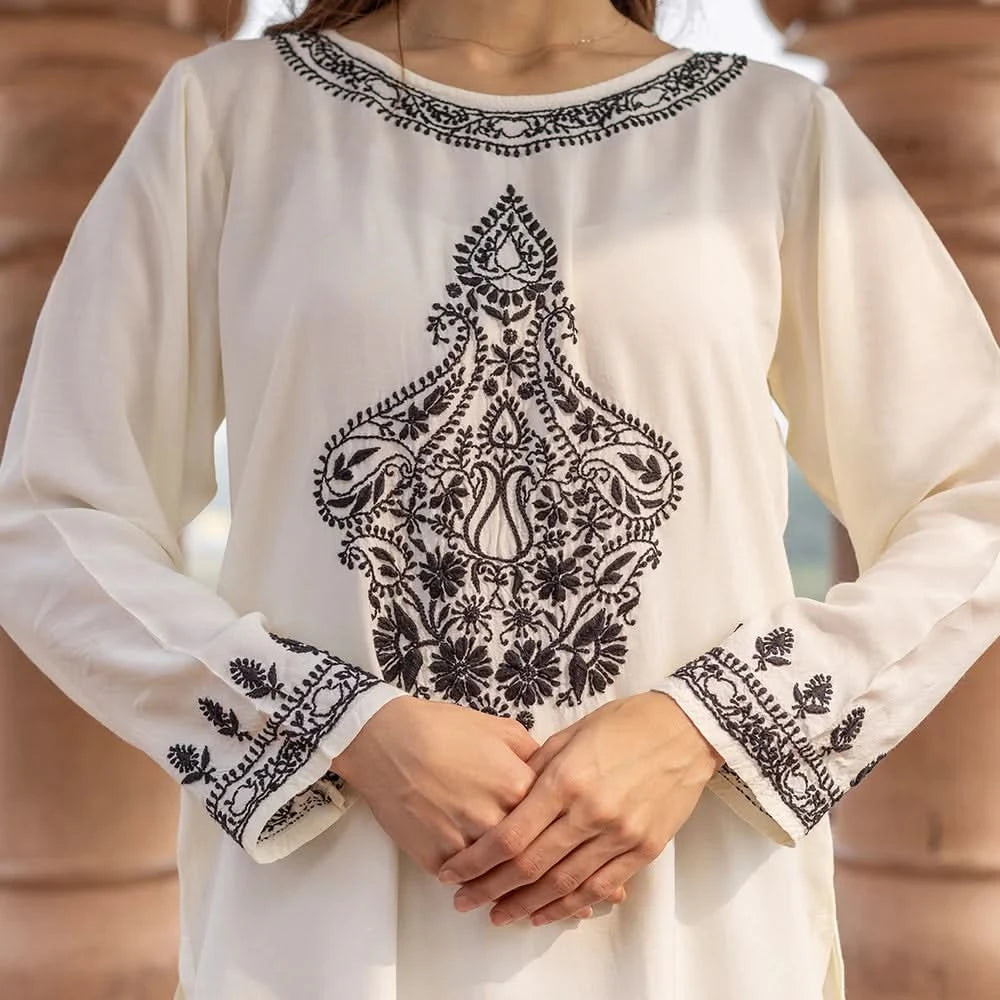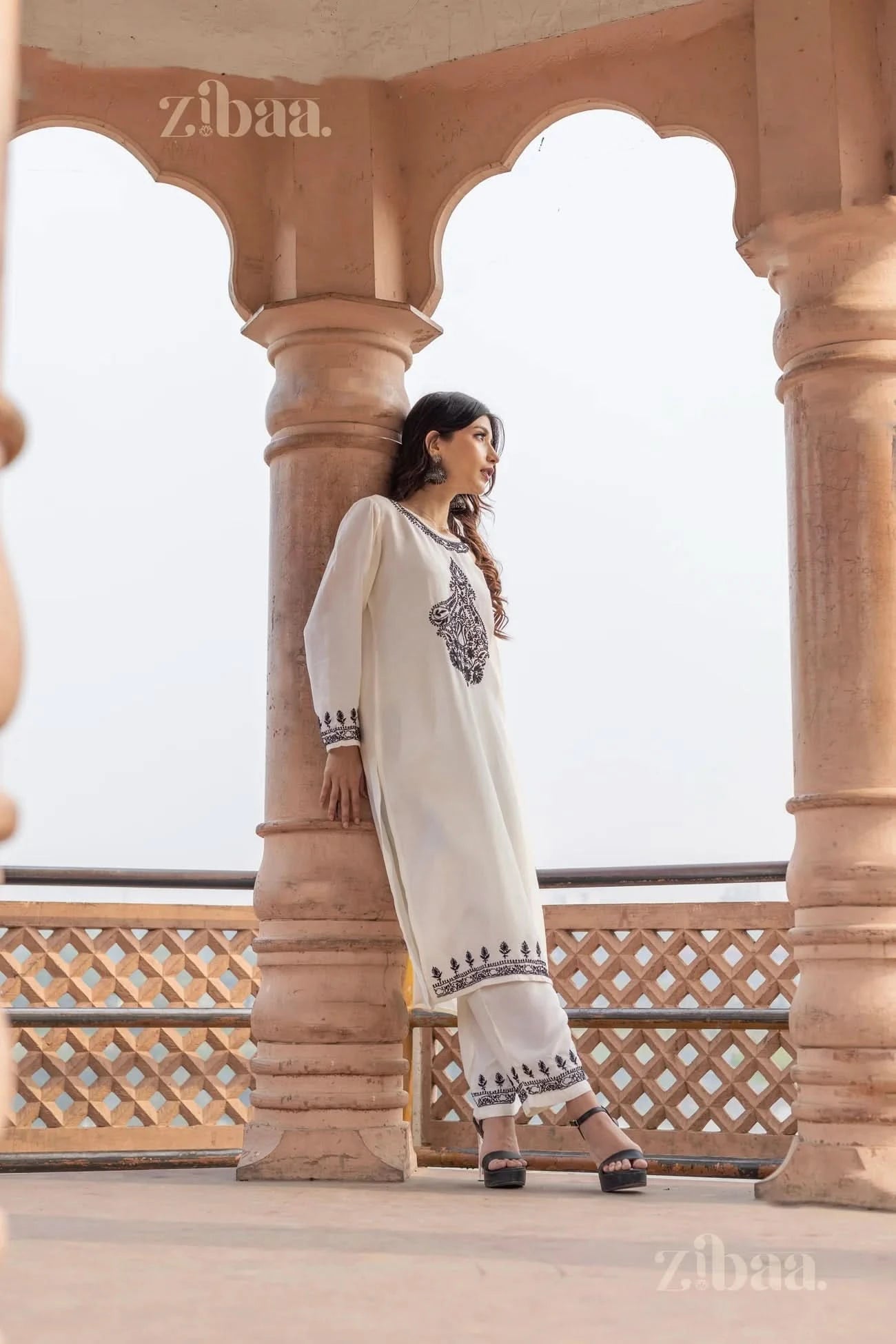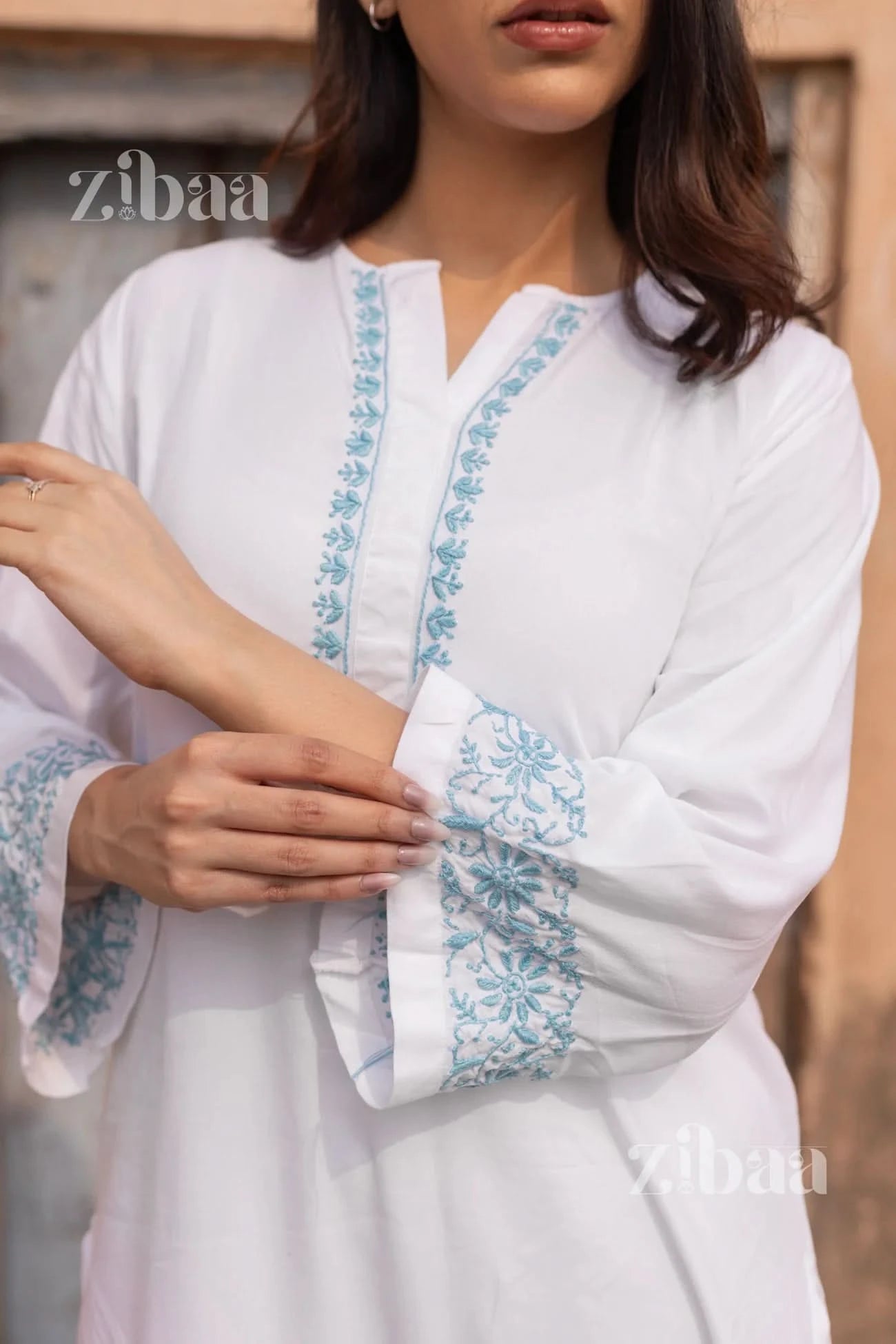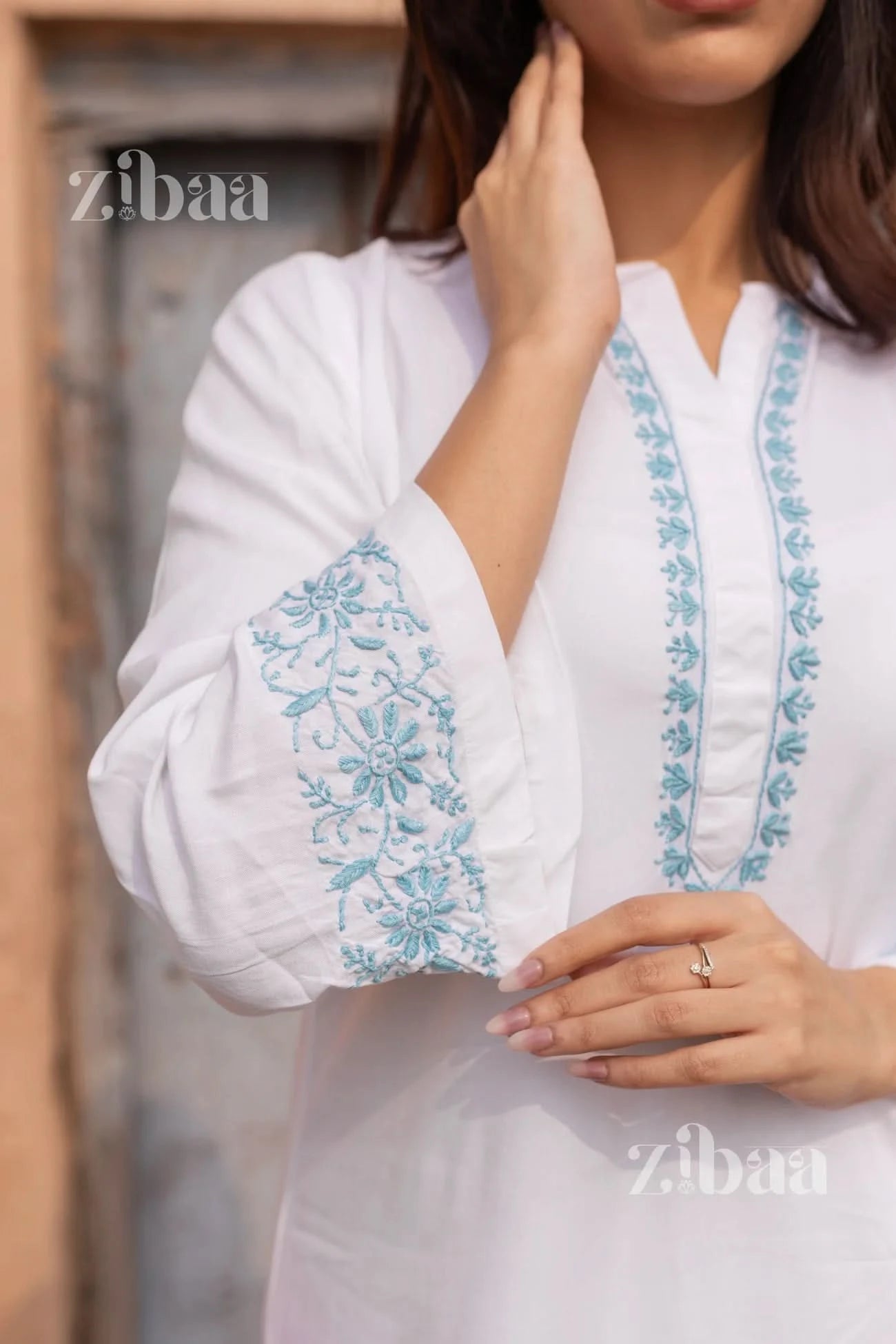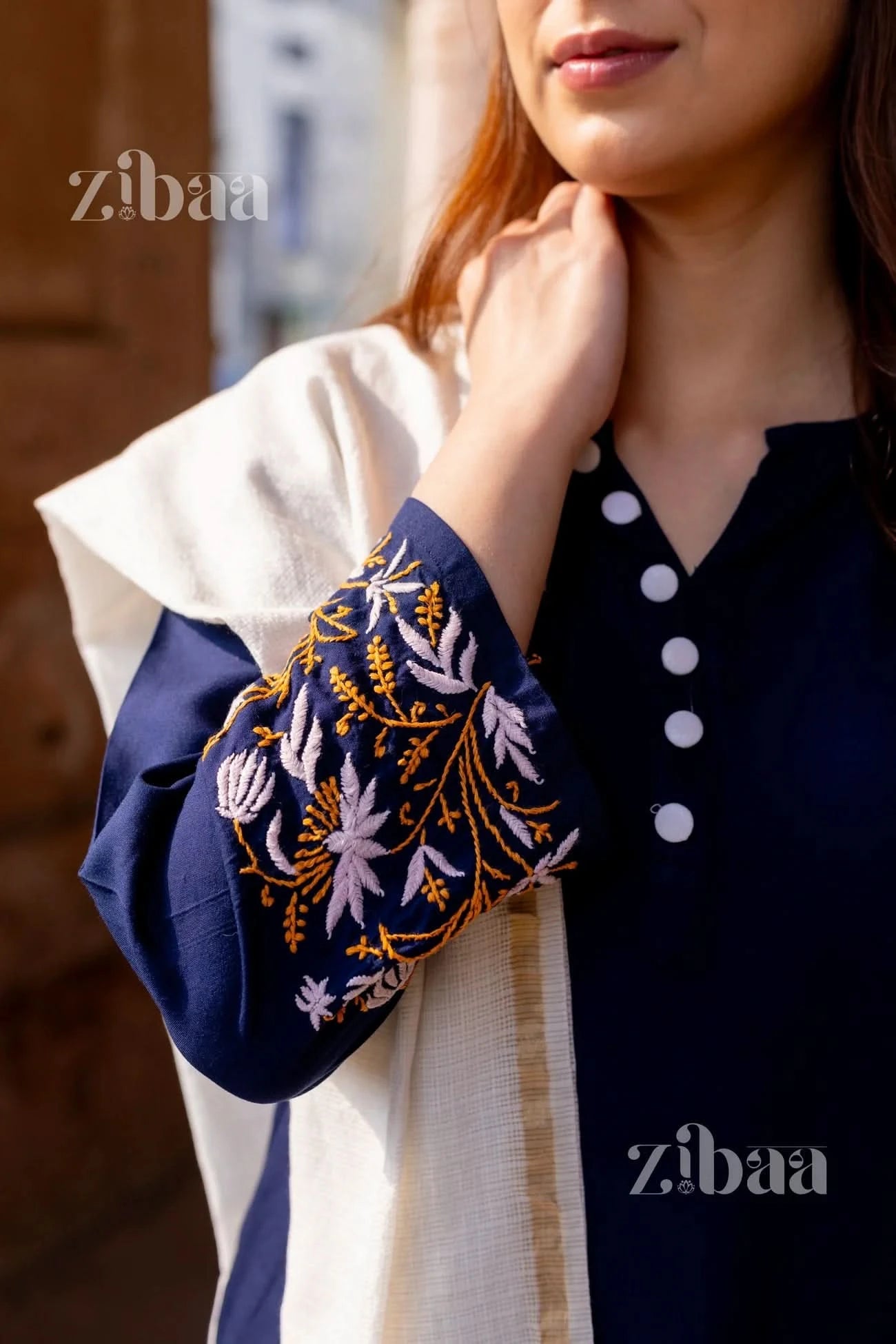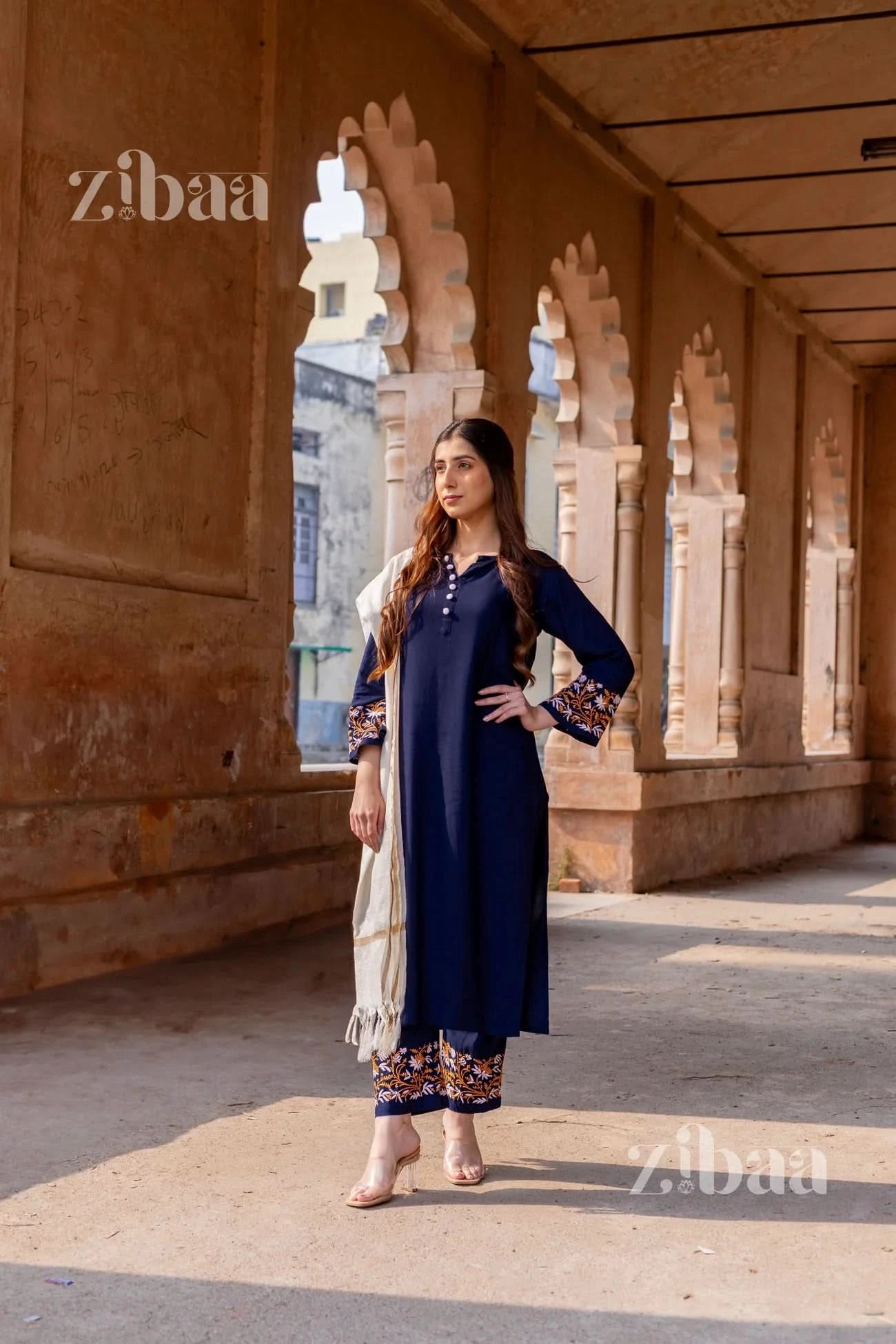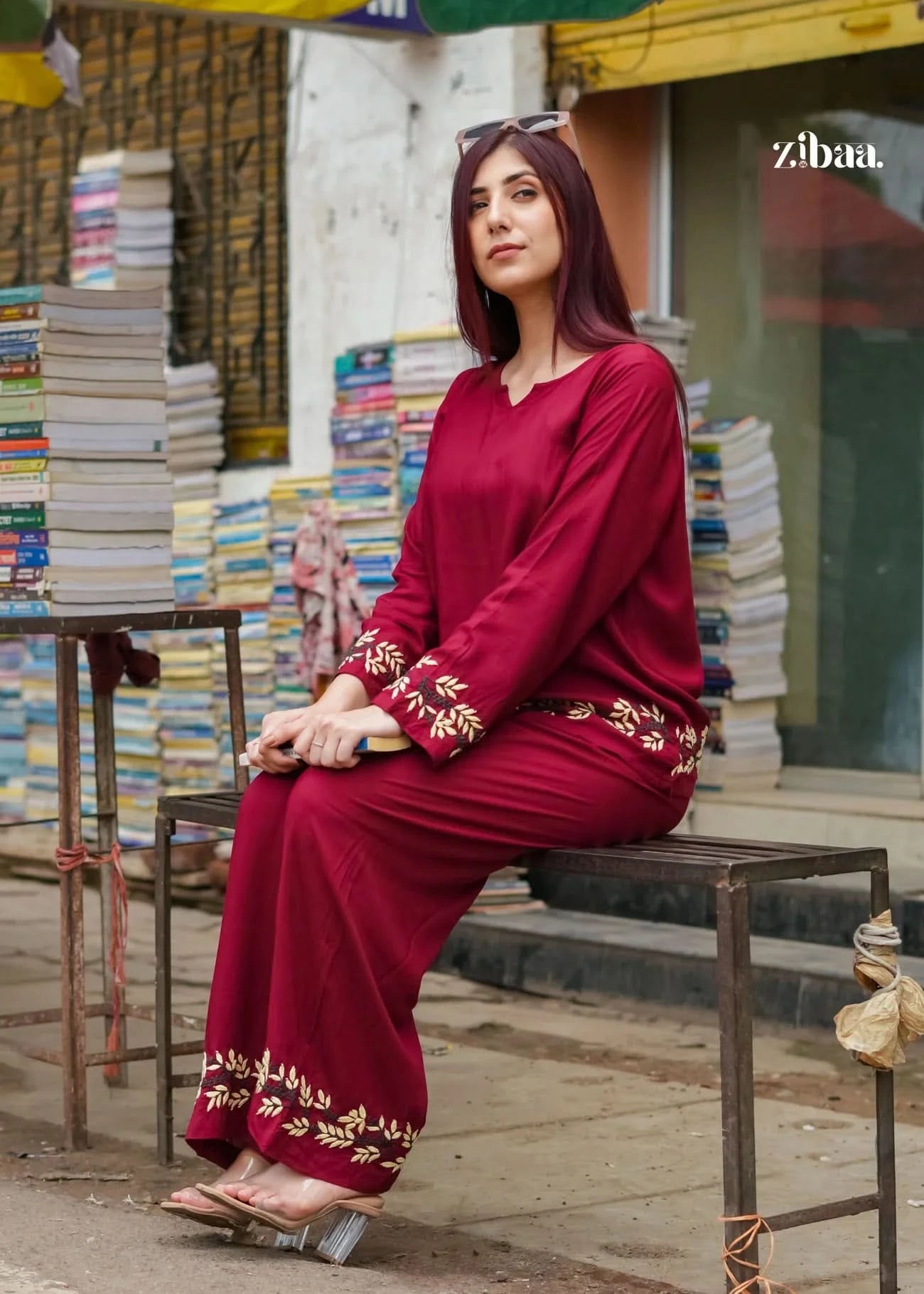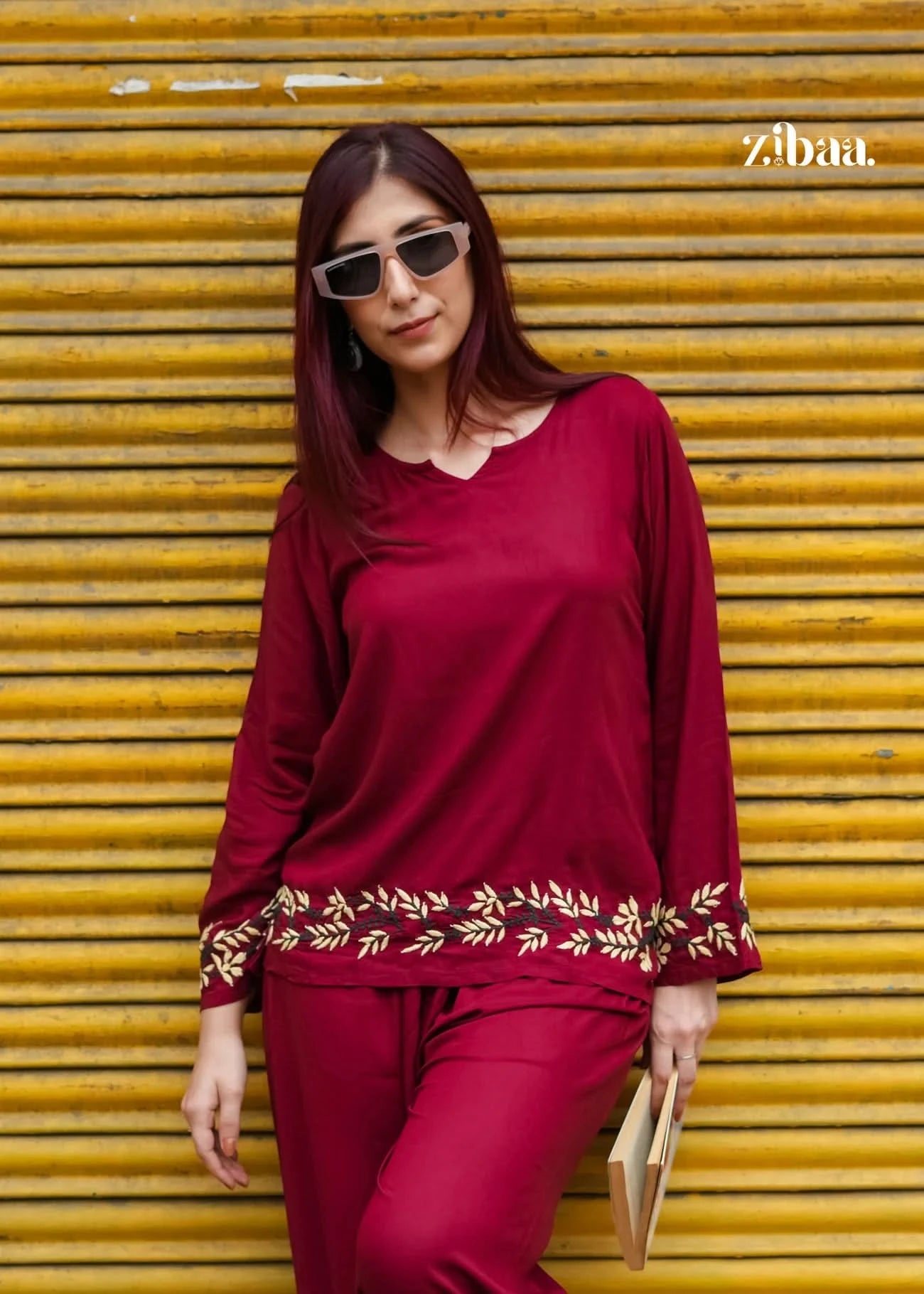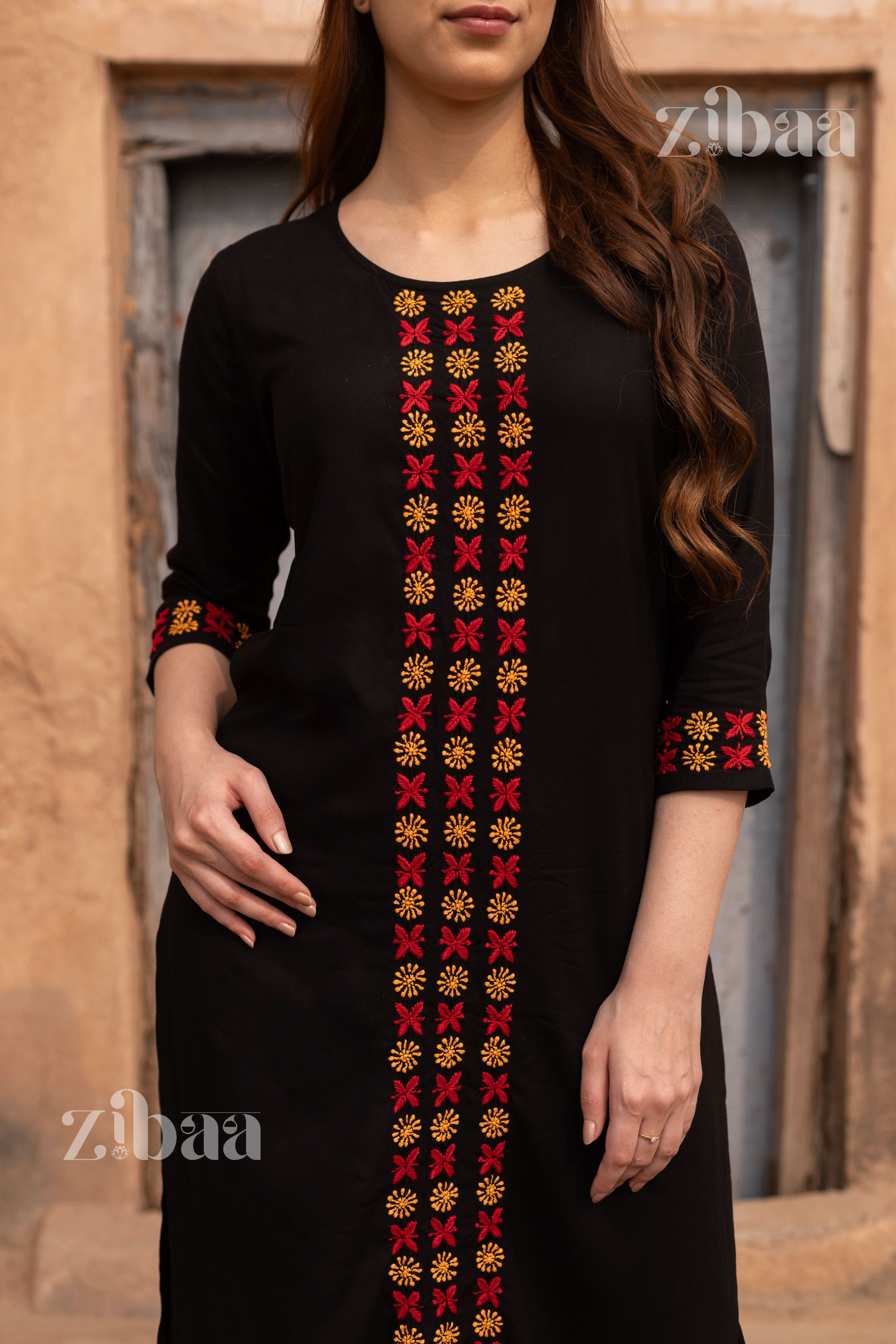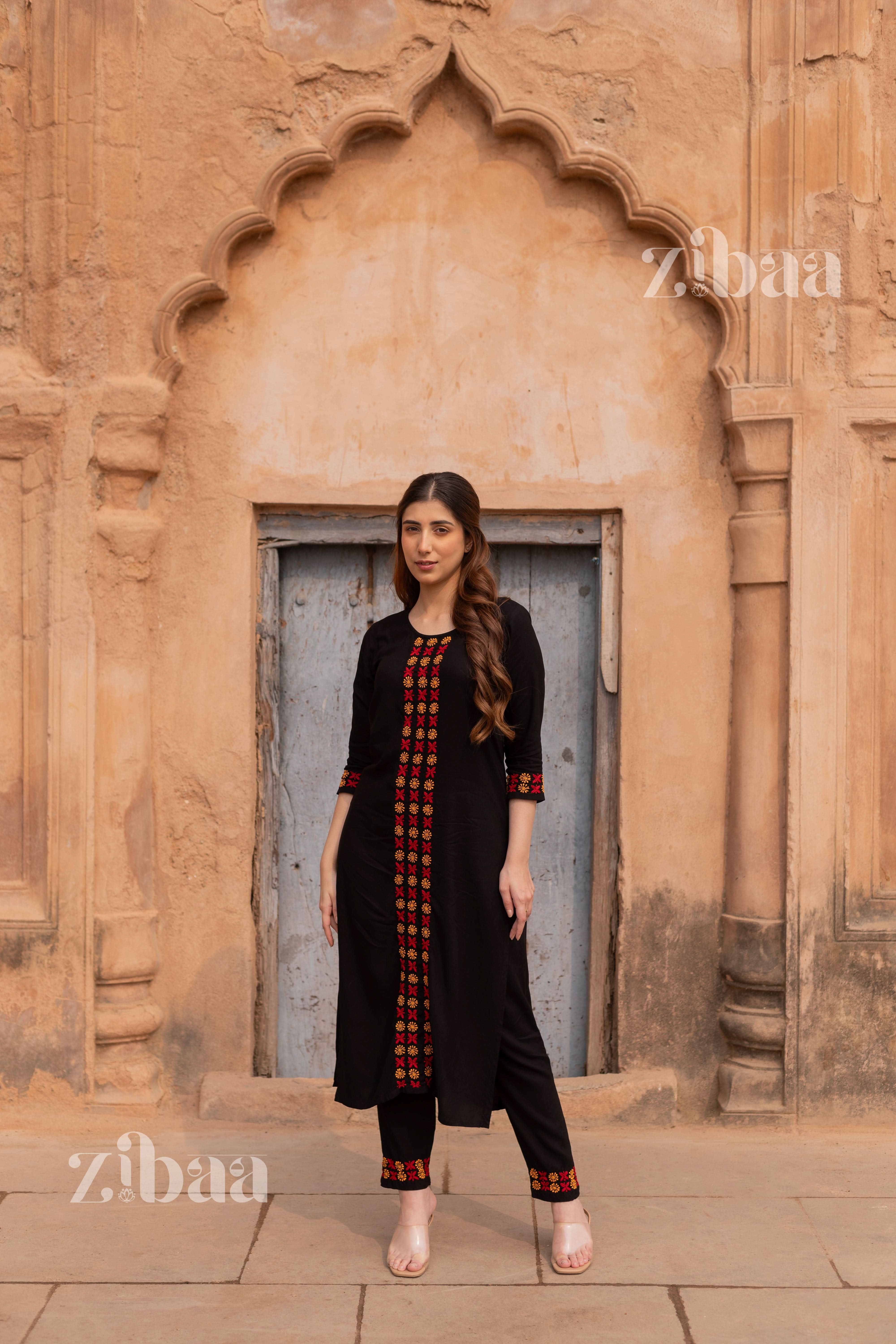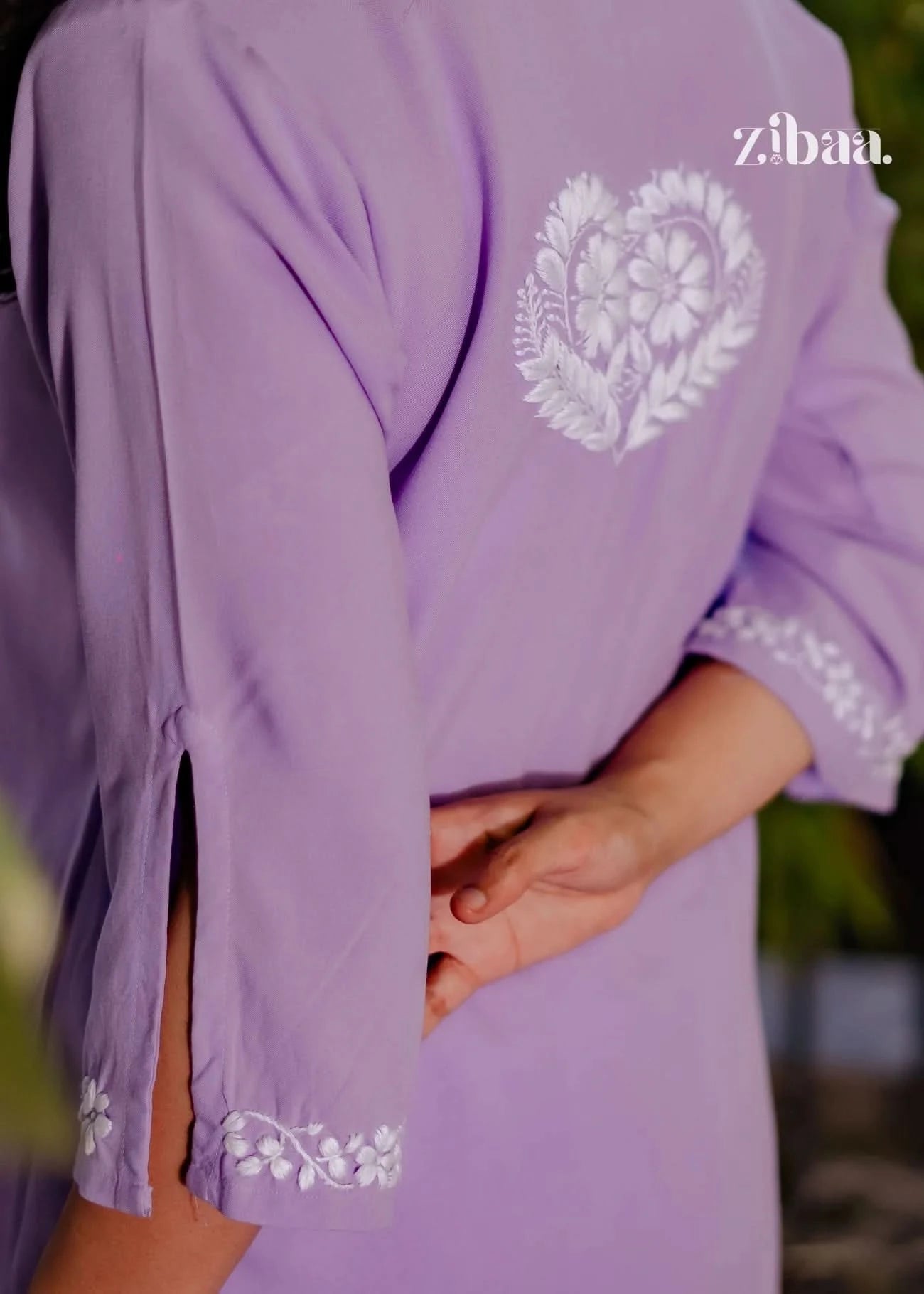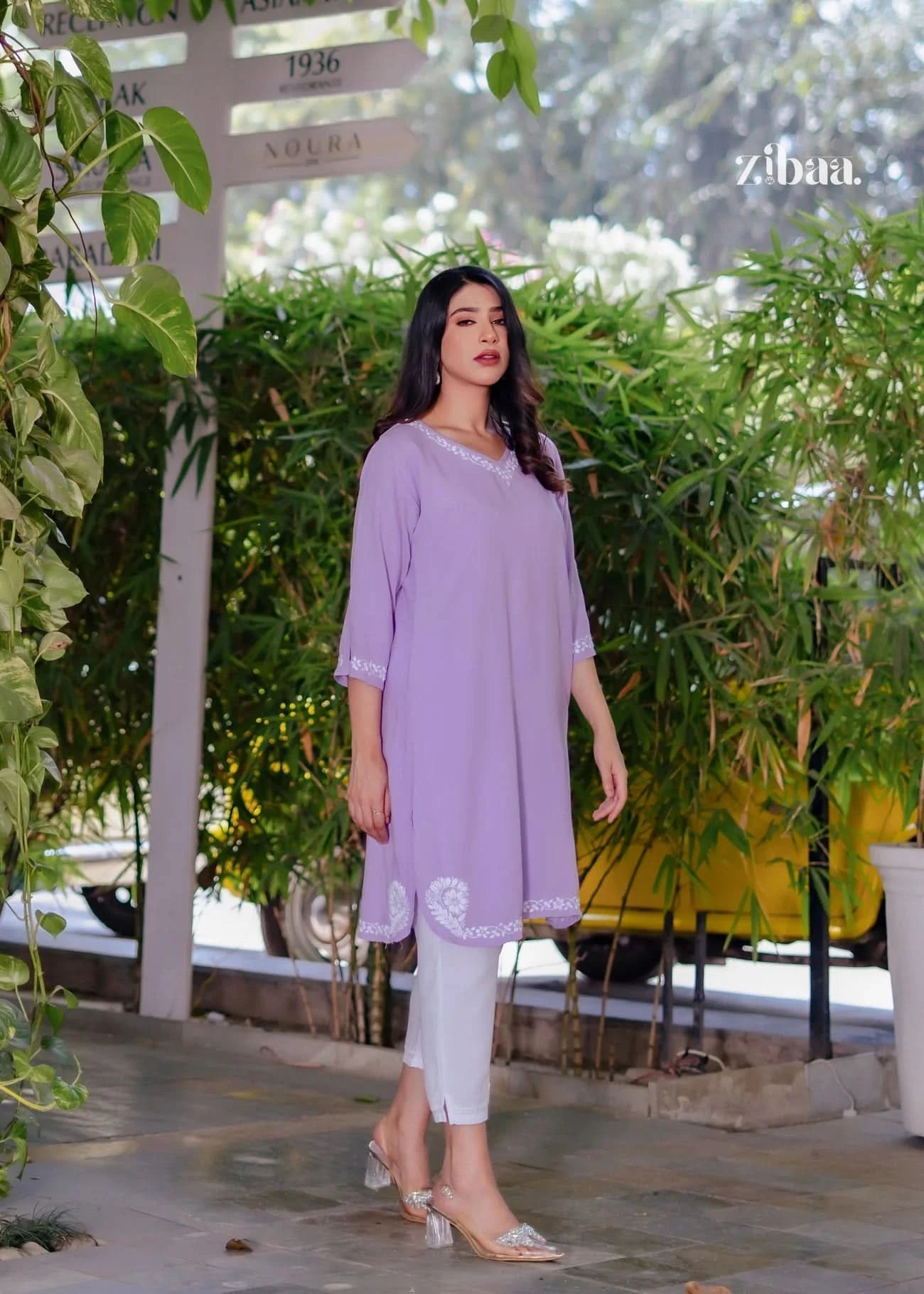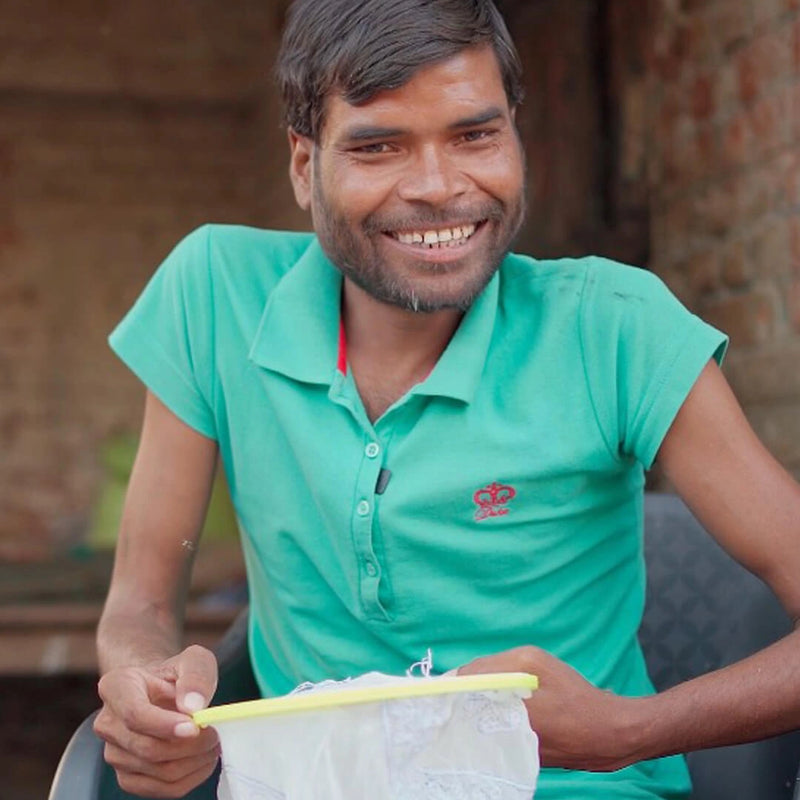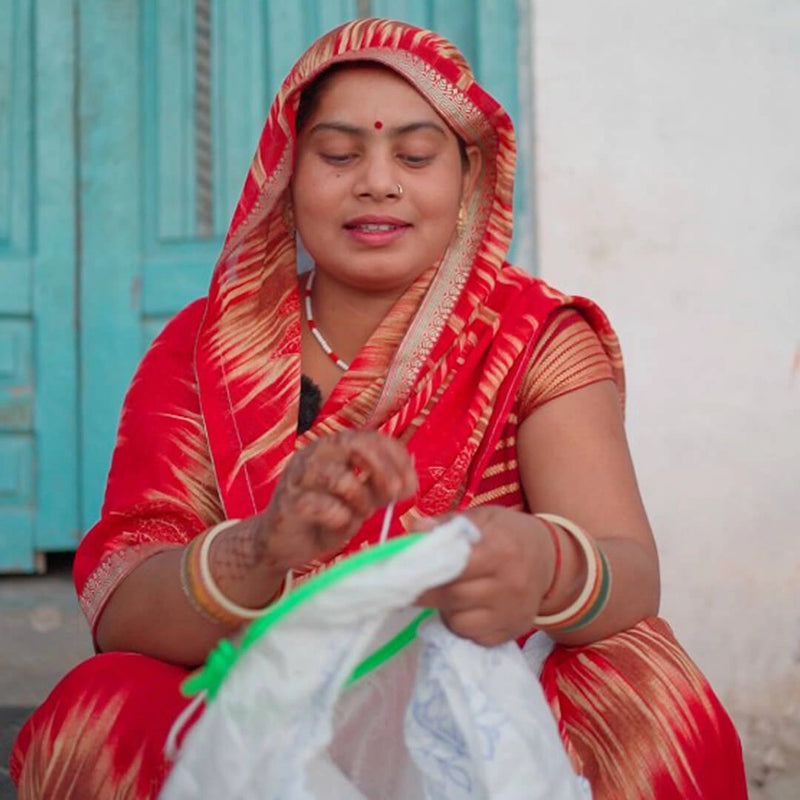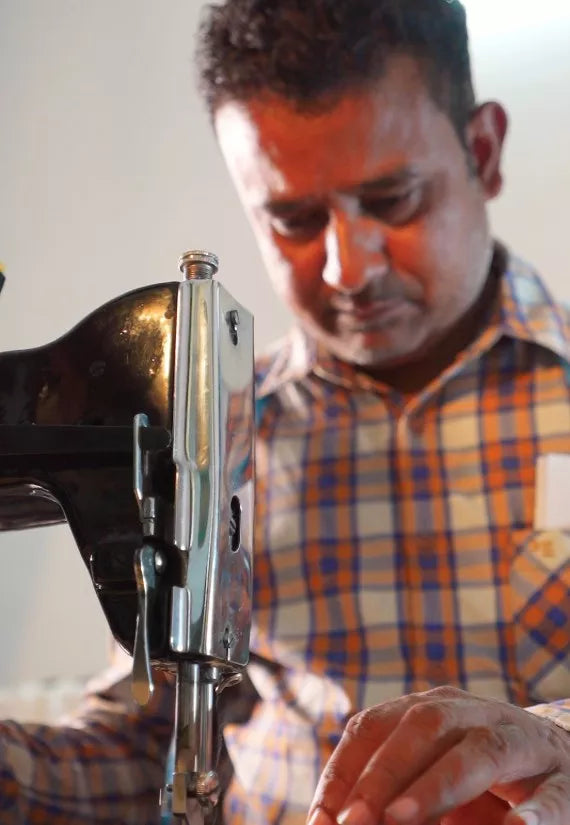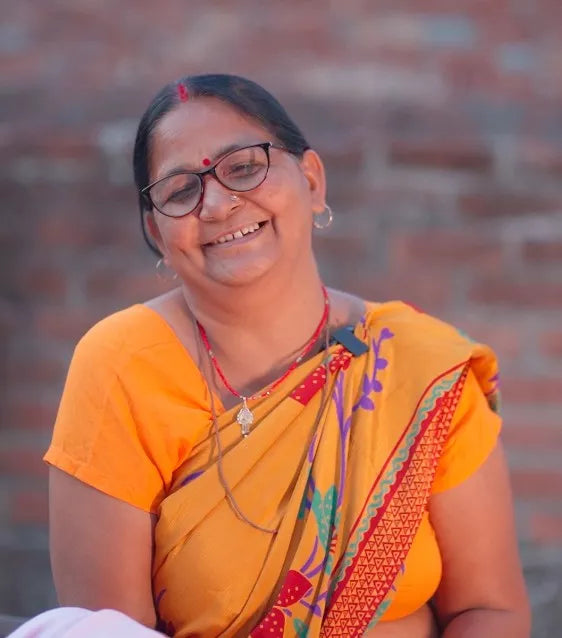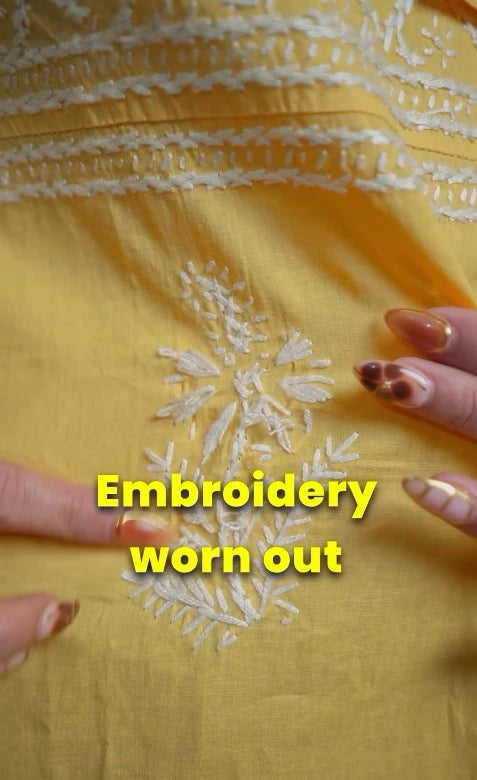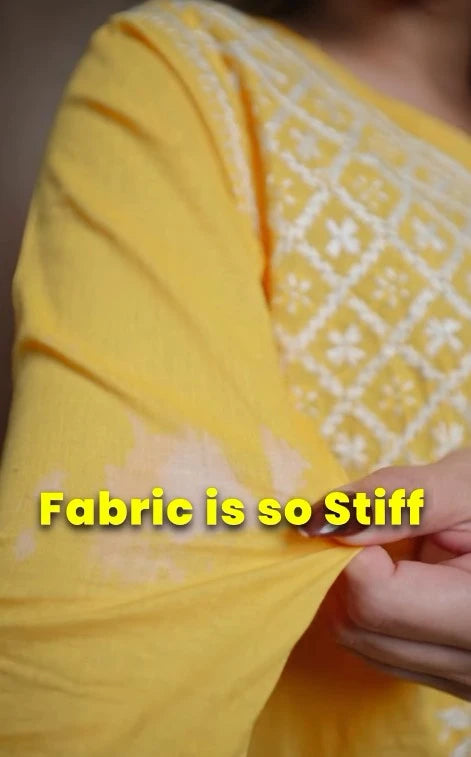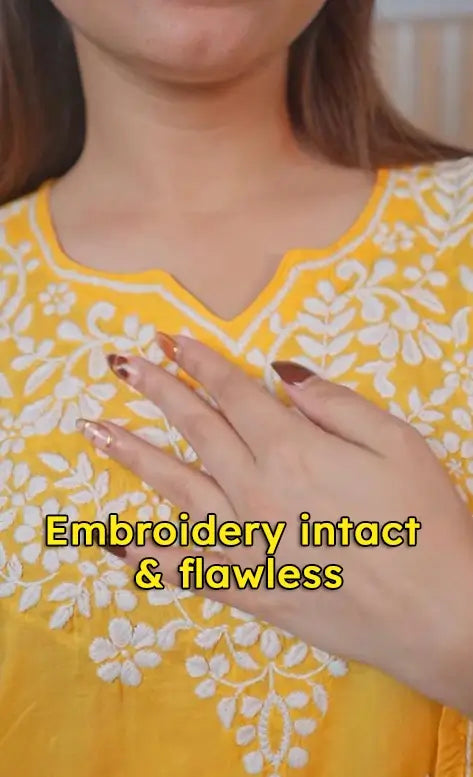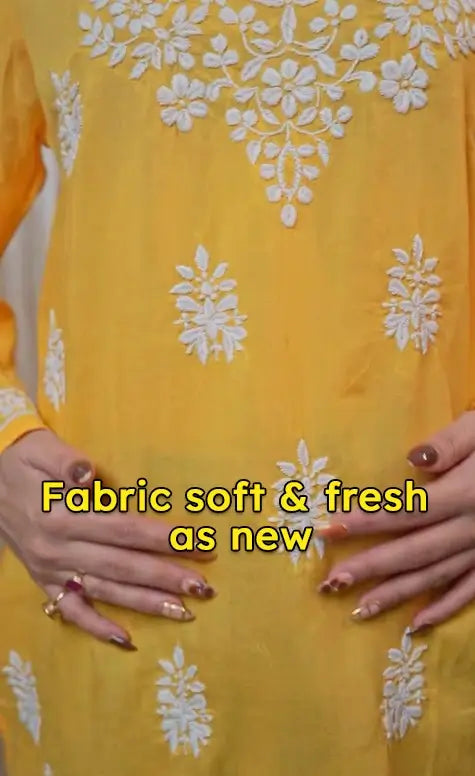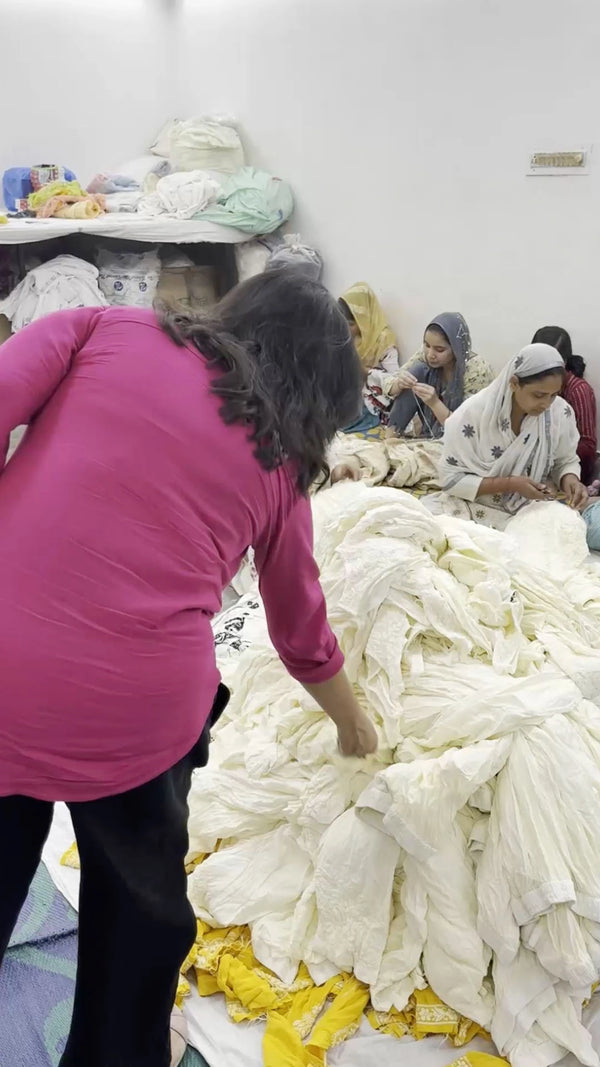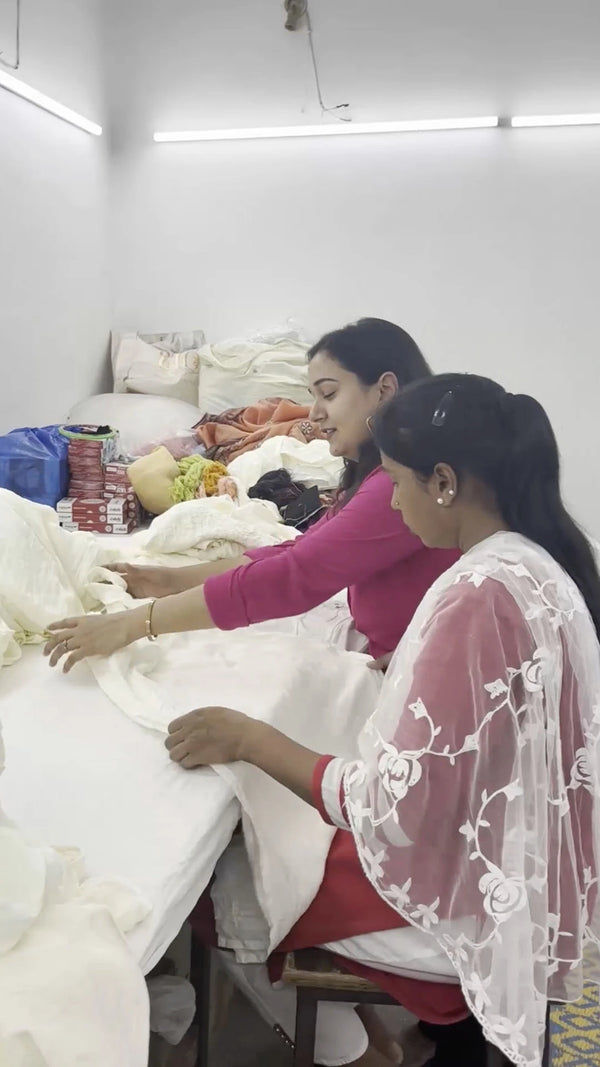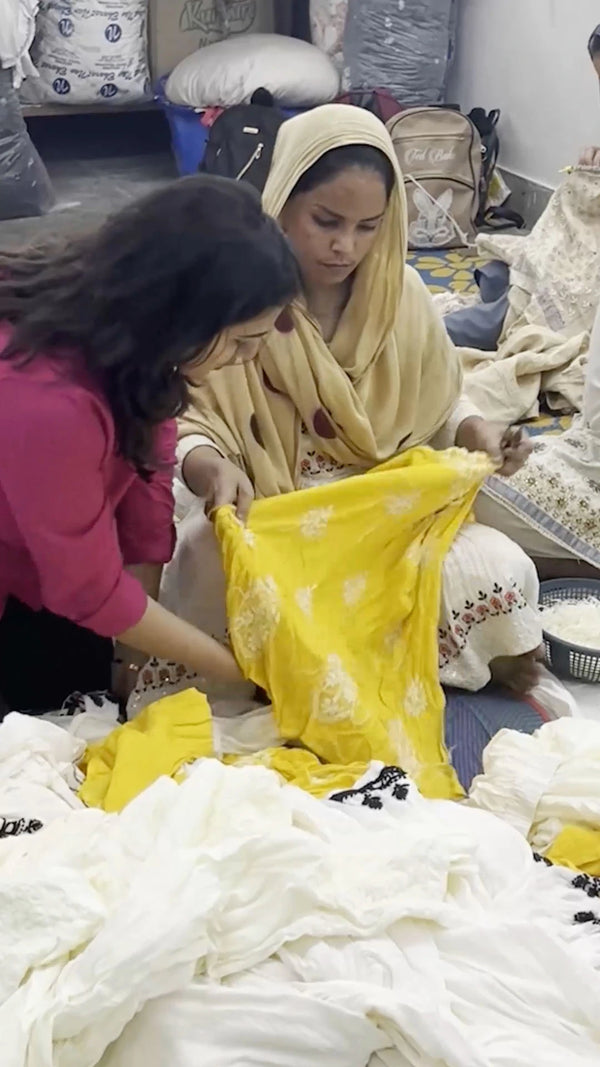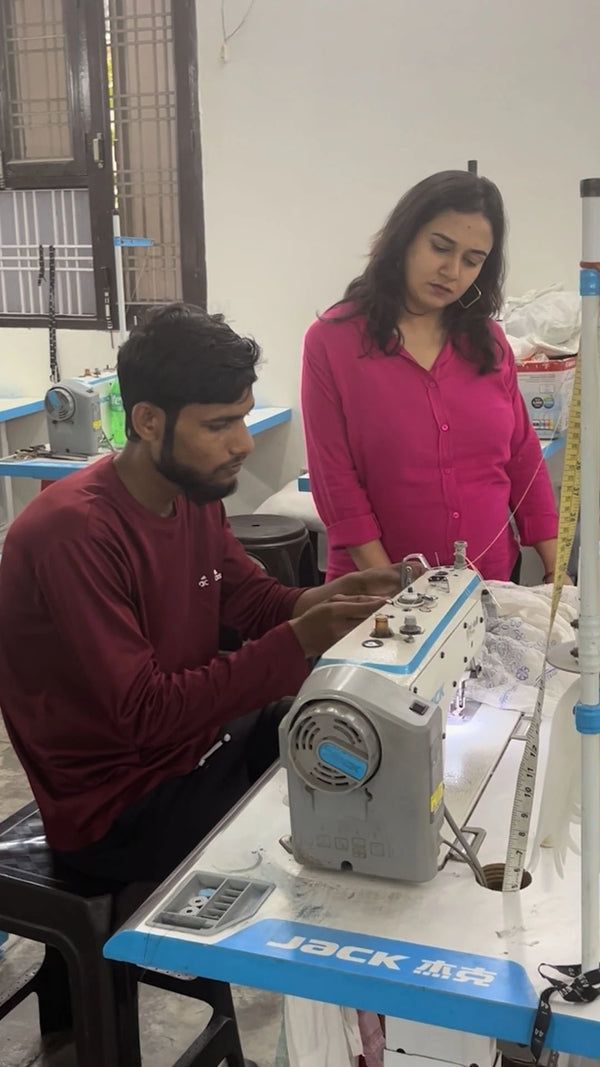Inception of Chikankari in India
Chikankari is a special kind of white embroidery done on fine muslin cloth. This delicate and intricate style of embroidery first came to India over 400 years ago.
It originated right within the city of Lucknow. During the Mughal rule around the 18th century, fine muslin cloth was manufactured in Lucknow. The city was also a hub for different crafts and textiles under the patronage of the Nawabs. This delicate embroidery craft evolved locally using the fine muslin fabric made here.
The Nawabs loved the wonderful chikankari work and supported its growth within Lucknow by providing patronage to the skilled craftsmen. Over time, it became an important part of the culture, identity and heritage of the city.
Though it began in Lucknow, this delicate embroidery was cherished by royalty across North India. The Nawabs often gifted these beautifully crafted fabrics to other royal families, helping the art gain recognition beyond its origins. Over time, skilled artisans from Lucknow traveled to other cities, spreading the craft and making it popular nationwide.
These are some reasons why Chikankari suit for women are so special:
-
Extremely delicate stitches: There can be over 65,000 stitches on just one chicken embroidery suit! Each small stitch is made by hand.
-
Threads used: Special kinds of fine muslin threads are used rather than silks. This allows the embroidery to match the sheerness and softness of the underlying cloth.
-
White-on-white work: Only white thread is used on the white muslin base giving it a very subtle, delicate look. Sometimes pastel shades may be used for accents.
-
Variety in stitches: Many types of stitches are used like tepchi, bakhia, jali, jaalis and more to create different designs and textures.
Therefore, the beautiful art of chikankari traces back its origins 400 years to Lucknow, where it developed under royal patronage and later spread across North India. The intricate white-on-white embroidery continues to be unique to this region even today!
Reasons for the growth of Chikankari art form in India
The detailed hand embroidery tradition from Lucknow, India has recently experienced a significant revival and growth. This elegant white-on-white stitch work has a history of 200 years, but had been losing popularity until the 2000s. There are a few things that have made this old-school handcrafted embroidery style hot again - not just in India, but worldwide.
Firstly, forming Self-Help Groups and Chikankari craft clusters supported by NGOs and government agencies helped develop infrastructure and provide stability in employment and income for craftspeople. Co-operatives and startups connecting artisans directly with buyers also empowered embroiderers.
Secondly, new entrepreneurs promoted the art form through geographical indication tagging and social media, attracting young consumers. Public figures like politicians, who associated Chikankari with tradition, further popularized it.
The most crucial factor though has been the online marketplaces launched in India over the last decade. Ecommerce websites offered a direct-to-consumer sales channel for Chikankari garments and products to every corner of India along with exports. This enormously widened the reach and revived demand.
Simplified online selling, free delivery, secured payments and return policies have encouraged consumers to confidently purchase traditional Chikankari pieces from cottage industry producers. Bulk orders and boutique customization brought more complex and premium Chikankari into fashion.
Revenue growth of Chikankari in India due to online contribution
|
Year
|
Revenue (in INR Crores)
|
Online Contribution (%)
|
Remarks
|
|
2018
|
100
|
10%
|
Initial phase of online presence
|
|
2019
|
130
|
20%
|
Increased online platforms
|
|
2020
|
160
|
35%
|
Boost due to pandemic and online shopping
|
|
2021
|
200
|
50%
|
Stabilization and growth in online sales
|
|
2022
|
250
|
60%
|
Further expansion in online markets
|
|
2023
|
300
|
70%
|
Continued growth and wider online reach
|
Major Indian Cities with High Demand for Chikankari Embroidery
Chikankari embroidery has been around in India for centuries, but its popularity has grown tremendously in recent years. This delicate and intricate white-on-white embroidery originating from Lucknow in Uttar Pradesh is now in high demand in all the major metro cities across the country.
The key factor driving the Pan-India demand for Chikankari outfits like suits, kurtis, sarees and anarkalis, is the versatility it offers. From daily wear to occasion wear, Chikankari adds graceful elegance perfectly suited for Indian ethnic sensibilities. A white Chikankari suit set or anarkali makes for an awesome festive wear. At the same time, one can wear it on a normal day by teaming it with a contrast colored dupatta. There are also options like Chikankari salwar suits that can be worn to the workplace. No wonder it is finding takers in all major tier-1 and tier-2 cities.
Metros like Delhi, Mumbai, Bangalore, Hyderabad, Ahmedabad and Kolkata are particular hotspots for Chikankari suits and ensembles. The influx of working professionals and new age women in these cities, with decent disposable incomes and orientation towards ethnic fashion, is driving the burgeoning market for this Lucknavi craft. Ecommerce has also enabled pan-India reach at the click of a button. Leading online fashion retailers and ethnic wear brands are ensuring easy availability of latest Chikankari styles like palazzos, gowns, sarees etc across India.
The minimalist elegance and versatile wearability make Chikankari a cherished fabric for modern Indian women. Surat, Jaipur and Varanasi too have developed as emerging hubs catering to the pan-India demand for this white embroidery craft of Lucknow. Chikankari's popularity is only expected to grow manifold in the coming years. The black chikankari suit is also very fashion statement for young girls.
Revenue growth of Chikankari in India over the last 5 years
Chikankari, the delicate white-on-white embroidery craft of Lucknow, has seen tremendous revenue growth over the last 5 years on the back of rising pan-India demand. As per industry estimates, the total market size for Chikankari ensembles like suits, kurtis, sarees and anarkalis has expanded at a compound annual growth rate of 25-30% since 2017. From a niche craft confined to Uttar Pradesh, Chikankari has now gained national popularity.
Top online fashion portals report booming sales of chikankari kurta sets, georgette suits and anarkalis from metros and tier 2 cities. The versatile ethnicity and classic grace of chikankari resonates perfectly with modern Indian women. With increasing disposable incomes and exposure through ecommerce, chikankari is poised for exponential growth in the coming years.
|
Year
|
Revenue (in Crores)
|
Growth Rate
|
|
2019
|
150
|
-
|
|
2020
|
180
|
20%
|
|
2021
|
220
|
22.2%
|
|
2022
|
270
|
22.7%
|
|
2023
|
330
|
22.2%
|
Chikankari suit : Introduction
Chikankari embroidery has its roots in the ancient cities of Lucknow and Murshidabad in India. This delicate needlework uses simple stitches like taipchi, bakhiya, jaali and murri to create intricate floral and geometric patterns on fabric.
The classic style is an all-white suit featuring floral chikankari patterns on the yoke, sleeves and hemline of the kurta. Anarkali style suits have long, flowing kurtas with embroidery all over. You'll also find chikankari on salwar suits, where the straight cut kurta is paired with churidars and an embroidered dupatta. White is a soothing color and chikankari fabric is breezy and breathable.
You'll find a wide variety of chicken embroidery suit online these days. Reputable websites offer the latest designs in chikankari suits - anarkalis, salwars, frocks etc - at reasonable prices. Go for pure cotton or muslin fabric with original Lucknawi chikankari work for best quality. Choose per your style and budget. Chikankari never goes out of style. A classic white chikankari suit with dupatta is a timeless addition to any Indian woman's wardrobe.
What Are Chikankari Suits?
Chikankari suits consist of three main components:
-
Kurta (Top): The centerpiece, adorned with delicate embroidery patterns.
-
Salwar/Palazzo (Bottom): Complements the kurta with fabric and style consistency.
-
Dupatta (Scarf): Often embroidered or finished with lace, enhancing the ensemble’s elegance.
Key Features of Chikankari Suits
-
Fabric Selection: Muslin, cotton, silk, and georgette are commonly used. Muslin and cotton are preferred in summers due to breathability, while silk and georgette suit formal occasions.
-
Embroidery Techniques: Over 30 distinct stitches—including Tepchi, Murri, Bakhia, Phanda, and Jaali—create intricate designs with depth and texture.
-
Design Motifs: Floral patterns, vines, paisleys, and geometric shapes dominate Chikankari embroidery, often inspired by nature.
-
Color Palette: While traditional white-on-white remains iconic, pastel shades and vibrant threads cater to modern aesthetics.
Example Garments:
-
Black Chikankari Kurti – Ideal for evening gatherings.
-
Blue Chikankari Kurti – Perfect for casual or semi-formal events.
-
White Chikankari Kurta – Suitable for traditional or formal occasions.
-
Chikanakri Embroidery Kurti – Combines classic handwork with contemporary styling.
-
Chikanakri Tops – Lightweight tops featuring delicate embroidery for casual wear.
Longevity and Durability of Chikankari Suits
Chikankari suits are highly durable when properly maintained, outlasting many other garments like kurtis and tops.
| Feature |
Chikankari Suits |
Kurtis |
Tops |
| Embroidery Quality |
Intricate, hand-stitched |
Simple/machine |
Minimal |
| Fabric |
Premium cotton/muslin/silk |
Varies |
Varies |
| Durability |
5–10 years+ |
2–4 years |
1–2 years |
| Cultural Significance |
High |
Moderate |
Low |
| Maintenance Requirement |
Gentle hand wash |
Machine washable |
Easy |
| Suitable Occasions |
Weddings, festivals, formal |
Casual, office |
Casual |
Why Chikankari Suits Last Longer:
-
High-quality threads and premium fabrics reinforce the suit.
-
Dense hand stitching prevents fabric fraying.
-
Classic, timeless designs maintain aesthetic appeal across decades.
Why Women Adore Chikankari Suits
Chikankari suits have consistently captivated women due to their elegance, versatility, and cultural resonance.
Top Reasons Women Choose Chikankari Suits:
-
Elegance: The intricate embroidery exudes refinement.
-
Versatility: Perfect for weddings, festivals, formal events, and casual gatherings.
-
Comfort: Breathable fabrics like cotton and muslin ensure all-day comfort.
-
Cultural Connection: Wearing Chikankari celebrates India’s artisanal heritage.
-
Sustainability: Handcrafted, slow-fashion appeal supports ethical and sustainable fashion practices.
Occasions to Wear Chikankari Suits:
-
Weddings and receptions
-
Festivals such as Diwali, Eid, and Holi
-
Formal office parties and social events
-
Casual family gatherings or day outings
-
Cultural ceremonies and heritage celebrations
Types of Chikankari Suits
Chikankari suits are available in multiple styles and fabrics, catering to diverse preferences.
| Type |
Fabric |
Stitch Complexity |
Best For |
| Lucknowi Chikankari |
Cotton/Muslin |
High |
Weddings, Festivals |
| Zardozi Chikankari |
Silk |
Very High |
High-end events |
| Georgette Chikankari |
Georgette |
Medium |
Semi-formal gatherings |
| Cotton Chikankari |
Cotton |
Medium |
Daily wear, casual events |
Modern Innovations: Pastel shades, fusion designs, and minimalistic embroidery are trending among young buyers.
What are the key steps involved in making traditional embroidered suits?
Cutting
First, the artisan decides the type of fabric to be used. Pure soft cottons like muslin, cotton voile, or cambric cotton are commonly used to make Chikan suits. The artisans carefully unfold the fabric to check for defects and cuts the required shapes for the suit pieces like the top, bottoms and dupatta as per measurements.
Stitching
The cut chikan fabric pieces are now hand-stitched together using traditional stitches to make the basic shape of the top/kurta, bottom/salwar and dupatta. Straight seams and basic hems are made by hand at this stage. The fabric may be double layered. For Chikankari white suit, the flared silhouette is achieved by gathering and attaching the bottom layers to the fitted bust panels.
Chappai
In this step, the artisan marks out the outlines on the stitched chikan suits to guide the hand embroidery work. Using light ink pens or removable tahiya, the design is drafted and the fabric is readied. Essential points, contours and lines are marked. Some portions may be starched too.
Embroidery
This is the most important step where the stunning chicken embroidery is achieved on the cloth. First the base material is mounted on a wooden stand ring or adda as it is called. The artisan then embroiders the handmarked design outlines very precisely with small uniform stitches using colored silken or cotton threads as per the pattern desired. Popular Chikan embroidery styles include delicate jaali, woven seedha-bakhiya, pechni, murri and zanjiri, among others mandating great precision and expertise. The depth and density is built up with multi-layered filling stitches.
Washing
Once the intricate embroidery is completed, the fabric is carefully washed multiple times in cool mild water using a very soft clean cloth or muslin to wipe the fabric gently ensuring the stitches stay intact.. This is carried out to remove all traces of markings as well as any dust or dirt and give the Chikan suits a neat look ready for dyeing.
Dyeing
White Chikan suits retain their exquisite look but colored Chikan suits also have huge demand. Soft pastel shades or vibrant tones and prints may be desired as per customer choices. For this the stitched and embroidered Chikankari fabric is washed, soaked and drained several times till saturation. After pressing out excess water, specific fabric dyes are used along with guarantee agents to uniformly color the fabric without affecting the embroidery.
Finishing
In this penultimate step, the dyed pieces of the Chikan suit undergoes thorough checks. Any loose knots or stray threads are trimmed. The fabric pieces are assessed for any pulls or snags in the base material and embroidery and rectified accordingly by expert hands. The suits are brushed, matched and pieces together to get them ready for dispatch after ironing and packaging.
Ironing
The final process involves steam ironing the finished chikankari suits. LINT-free cloth is used to avoid roughness and friction burns to the fabric surface or embroidery. Paper or cloth guards may be used to protect the embroidered areas when ironing if the design work is too dense. The Chikan work needs sensitive handling here to avoid flattening of motifs. Finally the crisp crease-free Chikan suits pieces are brought together, matched and packaged neatly ready for shipping.
Which stitching techniques are typically used in traditional embroidered suits?
|
Bakhiya Stitch
|
This is the most basic straight stitch used to outline the embroidery design on chikankari suits. It lends definition and brings sharpness. Bakhiya stitch is typically done using white thread.
|
|
Hool Stitch
|
Known as the seed stitch, it resembles creeper plants. Hool stitch has a curved, grain-like pattern used to fill shapes and gaps between embroidery motifs. It is a versatile filler stitch amply used in chikankari kurtis, suits and sarees.
|
|
Phanda Stitch
|
An overlay stitch forming small conical shapes resembling lemon wedges. Phanda lend texture and gradient effects through its overlapping arrangement. It beautifully fills between embroidered motifs.
|
|
Jaali Stitch
|
As the name suggests, jaali means net. This stitch uses an interlaced criss-cross pattern to create a perforated effect much like mesh/net fabrics. Jaali stitch adds intricate detailing.
|
|
Chain Stitch
|
Chain Stitch forms a linked loop pattern similar to chains. The continuous looping locks the thread firmly adding depth. Chain stitch outlines embroidered shapes with dimension and border designs.
|
|
Ghas Patti Stitch
|
Resembling grass blades, ghas patti features fern-like vertical straight stitches bunched together. It visually builds volume and fills backgrounds or negative spaces.
|
These hand-embroidered stitches elevate simple fabrics into artistic Chikankari suits perfect for occasions. Their eye-catching patterns beautifully adorn chikankari Anarkalis, long kurtis, cotton suits, georgette suits and more. Choosing pastel hues like white, yellow or subtle colors like red, pink, orange suits most outfits.
What fabric choices complement detailed hand embroidery on suits?
Chikankari embroidery has a delicate and intricate look that is best complemented by lightweight, sheer fabrics that allow the exquisite needlework to shine through beautifully. Here are some of the most ideal fabrics for chikankari suits:
1. Cotton Fabric
The most traditional and popular base fabric for chikankari embroidery is light and breezy cotton fabrics like muslin, voile, and cotton silk. The crisp texture of handloom cotton allow the jaali, murri, phanda and other fine stitches to stand out distinctly. Pure cottons in off-white, pastel shades or even deeper hues make for perfect chikankari suit fabrics.
2. Chanderi Maheshwari Silk
The gossamer soft Chanderi and Maheshwari silks dyed in pleasant colors are also much-loved fabrics for chikankari suits. Their lightweight textures highlight the delicate needlework. Side slits, flared anarkalis, flowing maxis suits in these traditional weaves look elegant when intricately hand embroidered.
3. Georgette
Sheer georgette is another feather-light fabric that lets the tiny stitches and knots of chikankari embroidery pop beautifully. Georgette chikankari suits with dense allover embroidery in floral vines, leaves and geometric patterns are very popular for festive and bridal wear. Flowy georgette anarkalis, long kurtas and maxi dresses make stunning outfits when covered in chikankari.
4. Kota Silk
The famously crisp Kota doria/Kota silk cotton fabric holds shape well while allowing the needlework motifs to shine through its transparent weave. Chikankari frock suit, A-line kurtas, crop tops and ankle-length dresses in this fabric look incredibly graceful. Kota silk chikankari outfits are perfect for daily ethnic wear.
5. Banarasi Silk Tissue
Opulent Banarasi silks like jamdani, brocade and tissue silks also team beautifully with intricate chikankari work. Kittas, lehengas and fusion gowns embroidered with chikankari in gold or silver zari threads on rich Banarsi fabrics spell grandeur. These make for heirloom chikankari outfits for trousseau collections and bridal wear.
So whether you like flowy cotton suits for regular wear or majestic silks for grand occasions, chikankari looks its absolute best on lightweight, diaphanous fabrics that elevate its fragile beauty. Shop for the choicest handcrafted chikankari suits online from trusted artisan brands.
Most treding colors for chikankari suit in summer
Most trending colors for chikankari suit in summer
White - White chikankari anarkali suit has a clean and soothing look that feels just right for hot and humid weather. Plus, white reflects away the strong sunlight - important when heat is at its peak. When worked on crisp white fabric, the intricate threadwork and floral motifs of chikankari embroidery really stand out beautifully. There is an understated elegance in white chikankari kurti set.
Pastels - Soft pastel shades like powder pink, lemon yellow, sky blue, peach and mint green make breezy options for summer chikankari suits. These muted tones allow the intricate threadwork to stand out. Pastel chikankari kurtis paired with contrast dupattas in vibrant hues make pretty Indo-western options.
Earthy hues - Earthy tones like beige, ivory, ecru and sand are soothing color choices for chikankari ensembles in summer. Team an ivory chikankari kurta with a sand colored palazzo or cigarette pants. You can also opt for beige chikankari cotton suits. These earthy suits have an understated elegance perfect for daywear.
Bright colors - Vibrant shades like red, yellow, royal blue and green can brighten up your summer wardrobe. Opt for a bright georgette anarkali chikankari suit in a jewel tone. Or pair a vibrant yellow chikankari suit with a white gharara. Colorful dupattas also enliven all-white chikankari suits. The red chikankari suit add drama, making them great for events.
So experiment with light hues, earthy tones as well as vibrant colors this summer season for statement chikankari looks. Choose breathable fabrics like cotton silk or chanderi. Pay attention to intricate jaali, phanda, murri work in floral vines, creepers and foliage motifs.
5 ways to style chikankari suit
Here are 5 stylish ways to wear a chikankari suit:
Simple Chikan Kurta with Straight Pants or Palazzos
A basic chikan kurta teamed with fitting straight pants or flowy palazzo pants makes for an effortlessly chic everyday look. Opt for a minimal embroidered kurta to let the intrinsic beauty of chikankari take centerstage. You can go for palazzos or churidars in a neutral shade like ivory or blush pink to complement the subtle work of the kurta.
Crop Chikan Tops with Skirts
Crop tops and skirts make a perfect fusion combination for the modern Indian woman's wardrobe. Pair an off-white chikankari crop top featuring delicate jaal embroidery with lehenga skirts or flared long skirts. This Indo-western look works beautifully for casual daywear as well as dressy evening looks.
Long Anarkali Style Chikan Suits
Nothing spells elegance more than a nicely embroidered chikankari anarkali suit in georgette or cotton. The regal full-length anarkali kurta with churidar pants makes for traditional attire that is perfect for festive and wedding wear. Play with unique necklines or backless styles along with ornate gotta patti and zardozi borders to amp up the style quotient.
Fusion Wear with Chikan Kurtis
Give your Chikankari Kurti an eclectic spin by teaming it with fusion wears like dhoti pants, patiala salwars, sharara pants or fusion skirts. Contrast it well with solid colored fusion bottoms for an eye-catching ensemble. Heavy work kurtis will look best to balance the indo-western look.
Capes and Jackets over Chikankari Kurtas
Layer your chikankari kurta with lightweight jackets, capes or shrugs to give it a contemporary twist. Options like see-through chikankari capes, brocade waistcoats or short jackets work very well over simple solid colored chikan kurtas. You can pick monotone chikankari pieces for the layers to complement the delicate jaal work.
Bollywood's love for chikankari suit
As summer approaches, we look towards our favorite Bollywood celebrities for inspiration on beating the heat in style. And there is one outfit that effortlessly manages both comfort and elegance - the classic chikankari suit.
Chikankari embroidery traces back to the Mughal era and lends an ethereal charm to any fabric it adorns. Over the decades, Bollywood divas have frequently been spotted donning beautiful chikankari suits in breezy fabrics like cotton, georgette and chiffon. The intricate chicken embroidery in vibrant hues elevates simple kurtas and adds a touch of grace.
Who can forget Rekha Ji gliding in like a dream in her white chiffon sari teamed with an ivory chikankari blouse in Umrao Jaan? The sheer poetic charm of chikankari against the white fabric epitomized Umrao's character. Deepika Padukone also slayed a similar look in chikankari anarkali suits in films like Bajirao Mastani and Padmaavat.
Kareena Kapoor Khan has rocked chikankari suits on numerous occasions. Remember her gorgeous burnt orange chikankari suit in Jab We Met? The vibrant color beautifully contrasted with the delicate white threadwork. She also looked ethereal in a white and blue chikankari salwar suit in Veere Di Wedding.
New age actors like Alia Bhatt and Anushka Sharma too have been spotted in trendy chikankari fusion wear. Who can forget Anushka Sharma acing the airport look in a peach chikankari kurta and jeans? Lucknowi Kurti sets clearly offer both ethnic elegance and versatility.
When we think timeless ethnic fashion, chikankari suits are wardrobe must-haves. Rarely does an outfit manage to be simultaneously royal yet understated. The intricate hand embroidery celebrates the craftsmanship of Uttar Pradesh's master artisans.
And the neutral palette gives it an advantage to be mixed and matched with contrasting dupattas and garments. No wonder chikankari continues to dominate Indian ethnic fashion after decades. We certainly cannot get enough of our favorite stars draped in these dreamy chikankari creations either.
Chikankari suits are timeless because they perfectly blend tradition with everyday comfort. This embroidery from Lucknow looks wonderful on soft and flowing fabrics like muslin, georgette, and silk. Whether wearing a comfortable cotton suit for daily wear or dressing up in an anarkali for special occasions, the delicate handwork adds an elegant touch.
The fine stitches create beautiful floral and leaf patterns that feel both classic and fresh. Pair these suits with bright dupattas or mix them with trendy bottoms like palazzos or skirts for a modern look. After a long day, slipping into a light cotton suit is one of the most comfortable things you can do, and the embroidery makes it feel extra special without being over the top.
For parties or weddings, a bold colorful suit with detailed embroidery always catches the eye. Every wardrobe should have at least one of these because they bring an effortless charm that never goes out of style.


